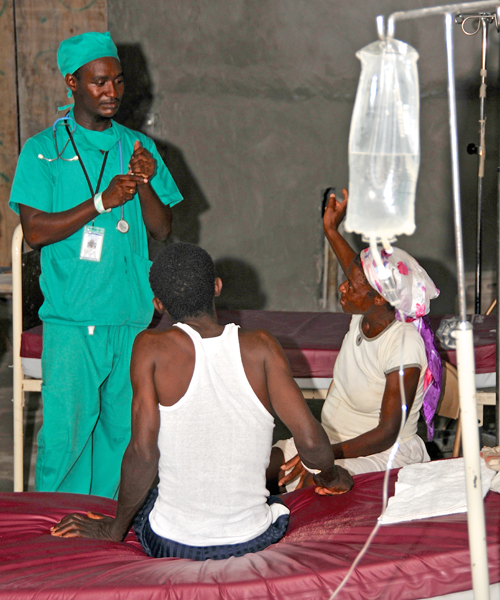Health Systems and Services
Health systems and services that are equitable, efficient, and well organized and that promote universal access are an essential foundation for improving the health of the population. Throughout 2012–2013, the Organization worked with Member States to strengthen health systems based on a renewed primary health care strategy and with a view to advancing universal health coverage.
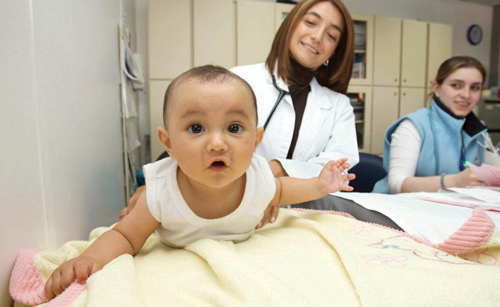 Bolivia, Costa Rica, the Dominican Republic, El Salvador, Guyana, Mexico, Uruguay, and the countries of the Caribbean all worked to advance toward universal health coverage with support from PAHO as well as the United Kingdom’s Department for International Development (DFID), the Australian Agency for International Development (AusAID), and the Spanish Agency for International Development Cooperation (AECID). PAHO’s work included support for the development of a roadmap outlining the path toward universal health coverage for Caribbean countries.
Bolivia, Costa Rica, the Dominican Republic, El Salvador, Guyana, Mexico, Uruguay, and the countries of the Caribbean all worked to advance toward universal health coverage with support from PAHO as well as the United Kingdom’s Department for International Development (DFID), the Australian Agency for International Development (AusAID), and the Spanish Agency for International Development Cooperation (AECID). PAHO’s work included support for the development of a roadmap outlining the path toward universal health coverage for Caribbean countries.
Information on out-of-pocket spending on health care was collected for Canada and the MERCOSUR countries to facilitate analysis of the determinants of such spending and the redistributive effects of public health expenditures. A number of health economics units from the Region’s ministries of health carried out discussions with partners including the UN Economic Commission for Latin America and the Caribbean (ECLAC), the World Bank, and the International Monetary Fund (IMF) on such issues as non-remunerated health care, “fiscal space,” and the prospects for expanding public health spending.
During 2012–2013, PAHO conducted or supported a number of studies on expanding health coverage. An analysis conducted in Brazil, Chile, Colombia, Jamaica, Mexico, and Peru examined which public policies were most likely to be effective in improving coverage and equity. A study in the Dominican Republic evaluated the financial impact of the health component in the country’s subsidized insurance scheme, while studies in El Salvador evaluated health reform gains and the challenges in consolidating them.
Eighty technicians from 18 countries took a virtual course on designing and managing health-care benefit packages. As follow-up, PAHO organized a community of practice for sharing information and experiences among personnel working on this issue. El Salvador, Mexico, Peru, and Uruguay have all developed or updated their guaranteed health-care benefit packages.
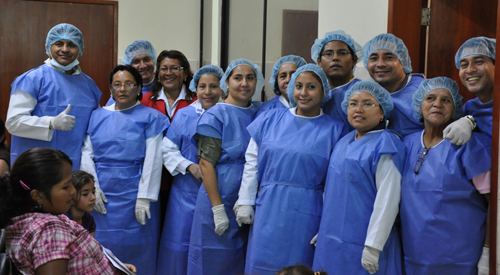 The Organization supported member countries in strengthening their legal frameworks to promote the right to health and access to care through a number of legislative and regulatory initiatives. As of 2013, 18 of the Region’s countries include the right to health in their constitutions, and in Chile, Colombia, Guyana, Haiti, and Peru the concept of social protection in health is a basic tenet in their health systems. The Organization helped Panama draft a new Health Code and supported El Salvador’s Ministry of Health in formulating legislation on vaccines that went into effect in January 2013.
The Organization supported member countries in strengthening their legal frameworks to promote the right to health and access to care through a number of legislative and regulatory initiatives. As of 2013, 18 of the Region’s countries include the right to health in their constitutions, and in Chile, Colombia, Guyana, Haiti, and Peru the concept of social protection in health is a basic tenet in their health systems. The Organization helped Panama draft a new Health Code and supported El Salvador’s Ministry of Health in formulating legislation on vaccines that went into effect in January 2013.
The Organization provided support for strategic planning and restructuring of health systems in Aruba, the Bahamas, and Curaçao as well as in the former Netherlands Antilles islands of Bonaire, Saba, and Sint Eustatius, which restructured their health sectors following changes in their constitutional status in 2010. To promote the primary health care approach to organizing health systems and services, PAHO created the Primary Health Care Collaborative Network, which allows experts from different countries to exchange information and identify and disseminate best practices. It has grown to some 450 members and 14 regional communities of practice and inspired the creation of similar communities of practice at the national level in Brazil and Chile. With PAHO support, Brazil implemented a program to improve access to and quality of primary care and completed evaluations for about half the country’s 40,000 primary care teams.
PAHO partnered with the Andalusian School of Public Health to validate a situation analysis for hospitals in 10 Latin American and Caribbean countries and territories—the Dominican Republic, El Salvador, Jamaica, Nicaragua, Panama, Paraguay, Peru, Puerto Rico, Trinidad and Tobago, and Uruguay—and worked with Colombia’s Antioquia National Faculty of Public Health to authenticate an analysis of emergency services in 14 countries. Health service managers in a number of countries used PAHO’s Productive Management Methodology for Health Services (PMMHS) to analyze the efficiency and quality of health care and the costing and financing of health-care services.
Chronic kidney disease from nontraditional causes in Central AmericaA disconcerting increase in chronic kidney disease from non-traditional causes (CKDnT) with high mortality has been observed in agricultural communities of Central America, mainly in El Salvador and Nicaragua. In response, the Member States of the Central American Integration System (SICA) and the Council of Ministers of Health of Central America and the Dominican Republic (COMISCA) issued the Declaration of San Salvador on CKDnT in April 2013. CKDnT was deemed a serious public health problem; urgent multisectorial, multidisciplinary, and participatory action was called to address it. As part of its technical cooperation, PAHO is supporting the strengthening of health surveillance systems and research capacity to better understand the causes and consequences of CKDnT, as well as providing support in the organization of health services. |
PAHO supported countries’ efforts to align their research policies with the regional Policy on Research for Health (CD49/10), approved by PAHO Member States in 2009, and with WHO’s 2010 Strategy on Research for Health (WHA63.21). During 2012–2013, the Council of Central American Ministers of Health (COMISCA) used the regional policy as a framework for establishing the Commission on Research for Health for Central America and the Dominican Republic. WHO’s Advisory Committee on Health Research worked with PAHO to develop a scorecard for monitoring the regional policy’s implementation.
 Also during the reporting period, 19 Latin American and Caribbean countries increased their share of clinical trials included in WHO’s International Clinical Trials Registry Platform, and Peru fulfilled the technical requirements for being included as a data provider in the platform. With support from a network of regional and international experts, 12 countries adopted standards and used platforms to translate knowledge into practice. Chile launched a platform for the review of research by ethics committees.
Also during the reporting period, 19 Latin American and Caribbean countries increased their share of clinical trials included in WHO’s International Clinical Trials Registry Platform, and Peru fulfilled the technical requirements for being included as a data provider in the platform. With support from a network of regional and international experts, 12 countries adopted standards and used platforms to translate knowledge into practice. Chile launched a platform for the review of research by ethics committees.
PAHO supported country efforts in the area of patient safety and infection control. Brazil launched a new National Patient Safety Program and developed legislation for implementing the program in its Unified Health System. The Bahamas developed a national action plan to improve prevention and control of healthcare-associated infections.
Human resources for health
PAHO worked with countries to improve planning and management of the health workforce, both in ministries of health and at the local level. This included support for several subregional efforts to improve policymaking and planning on human resources. PAHO’s Office of Caribbean Program Coordination coordinated with CARICOM ministries of health and other actors to develop a subregional human resources roadmap with specific milestones for improving the governance and skills of human resources in health in the Caribbean in 2012–2017. In the Andean region, the Organization helped develop a policy on human resources in health within the framework of the Andean Health Agency/Hipólito Unanue Agreement, approved by Andean health ministers in 2012. In its role as advisory body for COMISCA, PAHO worked with teams from Belize, Costa Rica, the Dominican Republic, El Salvador, Guatemala, Honduras, Nicaragua, and Panama, to implement the Development Plan for Human Resources in Health for Central America.
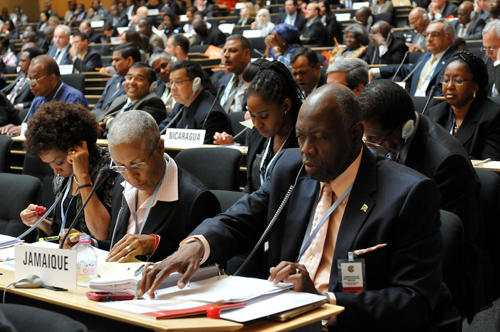 In collaboration with the health ministries of Jamaica, Peru, and Uruguay and the PAHO/WHO Collaborating Center on Health Workforce Planning and Research at Dalhousie University, Canada, and the Collaborating Center for Health Workforce Planning and Information at the University of the State of Rio de Janeiro, Brazil, PAHO helped design a regional initiative on human resource goals. It includes a second round of measurements of 20 regional goals for human resources in health for 2007–2015 and an analysis of human resource programs linked to priority goals at the national level.
In collaboration with the health ministries of Jamaica, Peru, and Uruguay and the PAHO/WHO Collaborating Center on Health Workforce Planning and Research at Dalhousie University, Canada, and the Collaborating Center for Health Workforce Planning and Information at the University of the State of Rio de Janeiro, Brazil, PAHO helped design a regional initiative on human resource goals. It includes a second round of measurements of 20 regional goals for human resources in health for 2007–2015 and an analysis of human resource programs linked to priority goals at the national level.
As part of the integrated strengthening of human resources, a proposal on competencies for pharmaceutical services was approved by representatives of pharmacy schools from 23 countries.
Between mid-2012 and mid-2013, more than 2,800 individuals participated in 67 courses offered by the Virtual Campus for Public Health on topics including aging and health, the right to health, essential public health functions, the renewal of primary health care, and gender. PAHO’s Edmundo Granda Ugalde program for leadership in international health provided education and training for 39 health professionals from 19 countries during 2012. In addition, PAHO supported efforts by 30 schools of medicine in eight countries—Argentina, Brazil, Chile, Canada, Colombia, Guatemala, Nicaragua, and the United States—to align their curricula with primary health care. PAHO’s Expanded Textbook and Instructional Materials Program (PALTEX) included 54 new books and issued 26 new editions during 2012–2013.
PAHO also played a key supporting role in facilitating South-South cooperation on human resources development involving Cuba and other countries in the Americas. During 2012–2013, more than 300 Cuban health workers conducted training activities outside Cuba, and nearly 800 health workers travelled to Cuba to attend events or participate in training.
The Regional Observatory of Human Resources in Health was consolidated as a platform for the exchange of experiences, information, and knowledge on human resources policies oriented toward universal health coverage and the development of health systems based on primary health care. By mid-2013, 12 countries had joined the observatory, facilitating online dialogue and sharing of experiences between countries and other stakeholders.
Medicines and health technologies
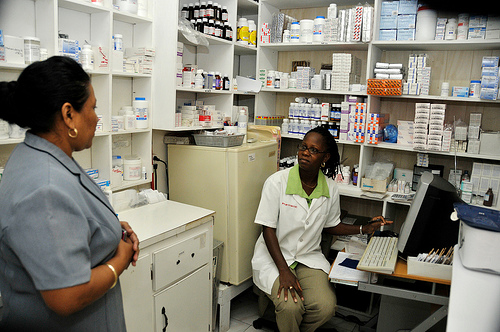 To strengthen national pharmaceutical policies, PAHO gathered information on 24 countries and made the results available to the respective Member States at a regional meeting in Quito, Ecuador, in 2013. The Organization prepared guidelines for developing pharmaceutical policies that encompass the right to health, universal health coverage, and social determinants involved in ensuring access to safe and effective medicines.
To strengthen national pharmaceutical policies, PAHO gathered information on 24 countries and made the results available to the respective Member States at a regional meeting in Quito, Ecuador, in 2013. The Organization prepared guidelines for developing pharmaceutical policies that encompass the right to health, universal health coverage, and social determinants involved in ensuring access to safe and effective medicines.
With PAHO’s support, the Council for Human and Social Development (COHSOD) approved the Caribbean pharmaceutical policy in 2012 and in the same year Barbados approved its National Pharmaceutical Policy. PAHO also supported El Salvador in the development and approval of the National Medicines Policy in 2012 and the creation of the National Regulatory Authority. Through regulatory measures, El Salvador achieved a 35% reduction in medicines prices.
PAHO helped strengthen the capacity of Mexico’s Federal Commission for Protection against Health Risks (COFEPRIS), which achieved recognition by PAHO as a Regulatory Authority of Reference in November 2012.
PAHO helped strengthen quality control of tuberculosis medicines in CARICOM’s drug control laboratories in Guyana, Jamaica, Suriname, and Trinidad and Tobago with funds from Argentina’s Ministry of Foreign Relations through the Argentine Fund for South-South and Triangular Cooperation (FO.AR.) The 10th phase of the external quality control program for laboratories from 23 countries began in late 2012 with the support of the US Pharmacopeial Convention (USP). PAHO also supported a South-South cooperation initiative in which Cuba worked with member countries of the Bolivarian Alliance for the Peoples of Our Americas (ALBA) in the area of pharmaceutical regulation.
With support from the Global Fund to Fight AIDS, Tuberculosis, and Malaria, PAHO assisted the Dominican Republic, Guatemala, and Honduras in preventing stock-outs of antiretroviral drugs by improving demand forecasting and other aspects of supply chain management. This work included the incorporation of a special drug monitoring tool into the Regional Platform on Access and Innovation for Health Technologies (PRAIS).
PAHO Strategic FundThe Regional Revolving Fund for Strategic Public Health Supplies, known as the PAHO Strategic Fund, continued to play an important role in promoting access to high-quality, essential public health supplies for Member States. From June 2012 through June 2013, 18 of the Region’s countries used the fund to purchase some $34 million in medicines and other essential public health supplies; seven used the fund’s capital account to avoid the risk of drug shortages. During the reporting period, PAHO updated the fund’s list of medicines to include 16 additional drugs for treating noncommunicable diseases (NCDs). |
As part of PRAIS, a new observatory on health technology, access, and innovation concluded its first year of operations in May 2013. In addition, indicators for the health technology sector were validated in 19 countries. By mid-2013, PRAIS had some 1,000 users and more than 20 active communities of practice sharing information to improve governance and the regulation of health technologies.
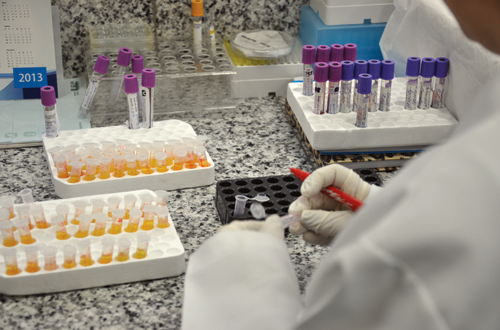 PAHO also supported initiatives to ensure the availability of safe blood and blood products in the Region. Technical and legal analyses and subregional plans for blood safety and HIV for 2013–2017 were prepared for the Andean region and for Central America and the Dominican Republic. A technical cooperation project involving PAHO and the blood products laboratory at the National University of Córdoba (Argentina) made it possible for Brazil to make significant advances in the safety of blood products and to strengthen production of blood products.
PAHO also supported initiatives to ensure the availability of safe blood and blood products in the Region. Technical and legal analyses and subregional plans for blood safety and HIV for 2013–2017 were prepared for the Andean region and for Central America and the Dominican Republic. A technical cooperation project involving PAHO and the blood products laboratory at the National University of Córdoba (Argentina) made it possible for Brazil to make significant advances in the safety of blood products and to strengthen production of blood products.
In partnership with the International Atomic Energy Agency (IAEA), PAHO collaborated in the development of the agency’s new (2016–2021) strategic plan and has played an important role in ensuring the safety and good working order of radiation therapy equipment in the Region. During 2012–2013, more than 150 pieces of radiation therapy equipment were inspected, and the IAEA’s thermoluminescent dosimetry (TLD) postal dose audit service was used to certify equipment calibration. A joint project with Rotary International installed and calibrated 30 pieces of basic digital radiography equipment in first-level care institutions in Guatemala. PAHO also worked with RAD-AID―a nonprofit organization dedicated to increasing radiology services in the developing world―to provide education and training, assessments, and equipment planning in Haiti. Trinidad and Tobago received support in managing radiation overexposure.
At the regional level, the 28th Pan American Sanitary Conference in September 2012 officially endorsed the new IAEA Radiation Protection and Safety of Radiation Sources: International Basic Safety Standards, which detail requirements for protecting people and the environment from harmful effects of ionizing radiation and ensuring the safety of radiation sources.
PAHO Member States in 2012 approved a resolution on Health Technology Assessment and Incorporation into Health Systems (CSP28.R9), which calls for strengthening and expanded use of evaluation processes to inform decision-making. The Health Technology Assessment Network of the Americas (REDETSA), which is coordinated by PAHO, increased participation to 25 members.
PAHO also worked in 2012–2013 to strengthen medicine-selection processes through both the Virtual Campus of Public Health and direct support for the development or updating of essential medicines lists in Barbados, Chile, Guatemala, Guyana, and Paraguay. This collaboration contributed to collective country savings of some $15 million in 2012.
The new Pharmacovigilance Group of the Pan American Network for Drug Harmonization (PANDRH) commenced activities in December 2012, in close connection with the Latin American and Caribbean Network of Drug Information Centers (RED CIM LAC). Regulatory authorities have been collaborating in pharmacovigilance through this mechanism.
Communicable Diseases
PAHO’s technical cooperation supported Member States’ efforts to reduce the burden of communicable diseases and to progress toward the elimination of those diseases considered eliminable. This work focused on strengthening capacity in disease prevention and control, preparedness, surveillance, detection, risk reduction, and response to hazards to human health, including events of potential international concern as defined in the International Health Regulations (IHR).
HIV, tuberculosis, hepatitis, and sexually transmitted infections
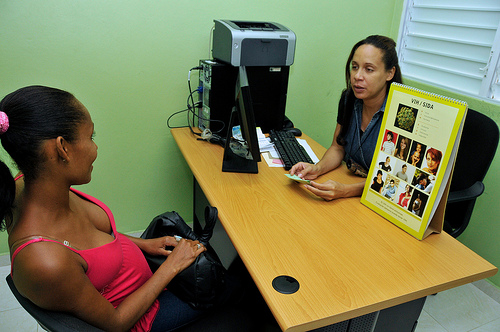 In 2012, PAHO’s program on HIV and sexually transmitted infections (STIs) conducted a mid-term evaluation of the regional HIV/STI Plan for the Health Sector 2006–2015. The estimated incidence of HIV infection in Latin America and the Caribbean had declined from 21.1 per 100,000 population in 2005 to 19.1 per 100,000 in 2011. Pediatric cases declined significantly during the period 2001-2011 by 60% in the Caribbean and 38% in Latin America. Increased access to antiretroviral therapy had contributed to a 36% reduction in HIV-related deaths in Latin America and a 50% reduction in the Caribbean during the period 2001–2010. As a result of the mid-term evaluation, PAHO refocused its HIV/STI technical cooperation on four priorities: treatment optimization, elimination of mother-to-child transmission of HIV and congenital syphilis, prevention and care for key populations, and strategic information.
In 2012, PAHO’s program on HIV and sexually transmitted infections (STIs) conducted a mid-term evaluation of the regional HIV/STI Plan for the Health Sector 2006–2015. The estimated incidence of HIV infection in Latin America and the Caribbean had declined from 21.1 per 100,000 population in 2005 to 19.1 per 100,000 in 2011. Pediatric cases declined significantly during the period 2001-2011 by 60% in the Caribbean and 38% in Latin America. Increased access to antiretroviral therapy had contributed to a 36% reduction in HIV-related deaths in Latin America and a 50% reduction in the Caribbean during the period 2001–2010. As a result of the mid-term evaluation, PAHO refocused its HIV/STI technical cooperation on four priorities: treatment optimization, elimination of mother-to-child transmission of HIV and congenital syphilis, prevention and care for key populations, and strategic information. To that end, PAHO organized subregional briefings for Latin American and Caribbean countries on the implementation of the Treatment 2.0 platform, which seeks to maximize the efficacy and effectiveness of HIV treatment. The Organization held two subregional meetings on the Treatment 2.0 framework. PAHO sent optimization missions to six countries—Bolivia, the Dominican Republic, Ecuador, El Salvador, Honduras, and Venezuela. These countries began implementing priority actions including voluntary migration of patients to preferred regimens, improvements in forecasting and supply chain management (supported by the PAHO Strategic Fund), strengthened community participation, decentralized services, and expanded access to HIV testing and counseling.
Together with the Global Fund to Fight AIDS, Tuberculosis, and Malaria, PAHO helped countries strengthen capacity for procurement and supply chain management to reduce stock-outs of antiretroviral drugs and related health products. A new regional platform to monitor antiretrovirals was created with support from the Global Fund and is being managed by the PAHO Strategic Fund.
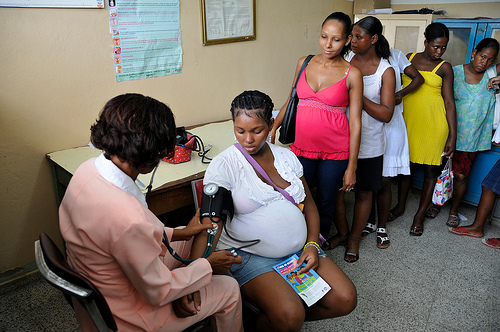 The Organization developed a methodology for validating the achievement of targets for eliminating mother-to-child transmission of HIV and congenital syphilis, which was implemented in pilot projects in Chile and Saint Lucia. A 2012 progress report based on the methodology showed that regional coverage of HIV testing among pregnant women had increased from 29% in 2008 to approximately 66% in 2011, estimated antiretroviral coverage for pregnant women with HIV had increased from 55% in 2008 to 70% in 2011, and new cases of HIV infection among children had dropped by 24% in Latin America and 32% in the Caribbean between 2009 and 2011. Six countries—the Dominican Republic, Guatemala, Mexico, Nicaragua, Panama, and Paraguay—had less than 50% coverage of HIV or syphilis testing for pregnant women in 2011. PAHO partnered with the U.S. Centers for Disease Control and Prevention (CDC) to help countries including Bolivia and Trinidad and Tobago review and revise syphilis-testing algorithms and introduce point-of-care testing.
The Organization developed a methodology for validating the achievement of targets for eliminating mother-to-child transmission of HIV and congenital syphilis, which was implemented in pilot projects in Chile and Saint Lucia. A 2012 progress report based on the methodology showed that regional coverage of HIV testing among pregnant women had increased from 29% in 2008 to approximately 66% in 2011, estimated antiretroviral coverage for pregnant women with HIV had increased from 55% in 2008 to 70% in 2011, and new cases of HIV infection among children had dropped by 24% in Latin America and 32% in the Caribbean between 2009 and 2011. Six countries—the Dominican Republic, Guatemala, Mexico, Nicaragua, Panama, and Paraguay—had less than 50% coverage of HIV or syphilis testing for pregnant women in 2011. PAHO partnered with the U.S. Centers for Disease Control and Prevention (CDC) to help countries including Bolivia and Trinidad and Tobago review and revise syphilis-testing algorithms and introduce point-of-care testing.
PAHO spearheaded the development of tools for providing comprehensive care for transgender persons and their communities. Based on expertise generated in this area, the Organization contributed to a technical dialogue for reframing transgenderism in the new International Classification of Diseases (ICD). It also facilitated training in Brazil and the Southern Cone countries on care for members of key populations and, in a collaborative effort with UN Women, developed a training package for health-care providers on integration of gender and human rights in HIV and sexual and reproductive health services. Also during the reporting period, Nicaragua’s National Assembly approved a new law that guarantees the rights of people with HIV, which PAHO supported by working with the assembly’s Health Commission and providing expertise for the national consultation.
By 2012–2013, the Region of the Americas had already achieved and surpassed the global Stop TB Partnership targets of reducing tuberculosis cases and deaths by 50% by 2015. According to WHO’s 2012 global TB report, the Americas had the highest annual rate of decline in TB incidence of any WHO region, at 4%. Nevertheless, multidrug-resistant tuberculosis (MDR-TB) and TB/HIV co-infection remain significant challenges for the Region.
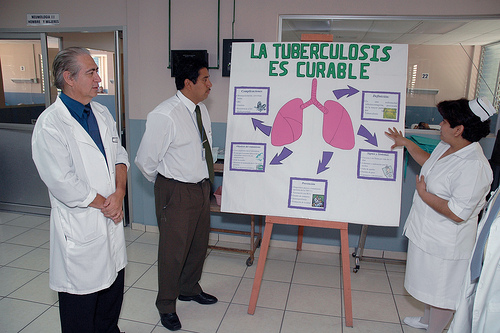 During 2012–2013, 21 countries were implementing nationwide programs for PAHO-recommended case management of MDR-TB, 20 countries had introduced new technologies for TB diagnosis (GenXpert and line probe assays, LPAs), and 13 countries had adopted special approaches to TB control in indigenous populations.
During 2012–2013, 21 countries were implementing nationwide programs for PAHO-recommended case management of MDR-TB, 20 countries had introduced new technologies for TB diagnosis (GenXpert and line probe assays, LPAs), and 13 countries had adopted special approaches to TB control in indigenous populations.
In partnership with USAID, PAHO supported the implementation of a special framework for TB control in large cities in three pilot cities: Bogotá, Colombia; Guarulhos, Brazil; and Lima, Peru. Suriname adopted a new National Strategic Plan for Tuberculosis Control, and a new regional Center of Excellence for Tuberculosis was established in El Salvador to train new staff members of TB programs on implementing the “Stop TB” strategy.
PAHO developed a comprehensive regional strategy on viral hepatitis infection for the Americas. Seventeen countries expressed support for the strategy, and Argentina, Brazil, Colombia, Jamaica, and Peru have begun implementing specific activities aligned with it.
Neglected, tropical, and vector-borne diseases
During the reporting period, malaria remained endemic in 21 PAHO member countries, but 12 countries had already attained the MDG target for malaria, with cases reduced more than 75% since 2000. Several countries were moving beyond control toward elimination. In 2012–2013, Costa Rica and Ecuador joined Argentina, El Salvador, Mexico and Paraguay in the pre-elimination phase, by reducing cases to under 5 per 1,000 population and rolling out national elimination plans. Guatemala and Nicaragua remained in control phase but reoriented their national malaria programs toward action for pre-elimination. Guyana and Haiti both updated their malaria strategic plans, and Guyana also took steps to strengthen its malaria surveillance system and improve its rapid-response capacity. The countries of the Guyana Shield—Brazil, French Guiana, Guyana, and Suriname—strengthened cross-border coordination of their malaria control efforts.
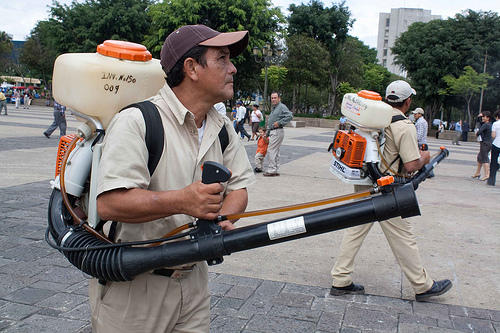 Continuing improvements in malaria pharmacovigilance helped the countries better monitor the development of anti-malarial drug resistance. Routine antimalarial surveillance by Suriname detected a potential loss of sensitivity of first-line malaria drugs. Other achievements in 2012–2013 included the launch of a new regional Malaria Research Agenda and procurement of malaria medicines and supplies through the PAHO Strategic Fund by 12 countries. In addition, PAHO recognized and promoted malaria “best practices” from Brazil, Ecuador, and Paraguay through its Malaria Champions contest, honoring the winners on Malaria Day in the Americas 2012.
Continuing improvements in malaria pharmacovigilance helped the countries better monitor the development of anti-malarial drug resistance. Routine antimalarial surveillance by Suriname detected a potential loss of sensitivity of first-line malaria drugs. Other achievements in 2012–2013 included the launch of a new regional Malaria Research Agenda and procurement of malaria medicines and supplies through the PAHO Strategic Fund by 12 countries. In addition, PAHO recognized and promoted malaria “best practices” from Brazil, Ecuador, and Paraguay through its Malaria Champions contest, honoring the winners on Malaria Day in the Americas 2012. During 2012–2013, Aruba, Bonaire, Curaçao, Jamaica, Sint Eustatius and Sint Maarten developed new strategies for integrated management of dengue prevention and control, El Salvador increased funding for the implementation of its existing strategy, which emphasizes broad intersectoral action. Bolivia and Chile achieved improvements in their dengue programs’ performance. The progressive introduction of WHO’s new classification of dengue in seven countries—Bolivia, the Dominican Republic, Guatemala, Honduras, Mexico, Panama, and Paraguay—improved patient care by increased detection of potentially severe cases.
Countries continued their efforts to fight neglected infectious diseases, achieving several important milestones during the reporting period. Belize was certified in November 2012 as having interrupted transmission of Chagas disease by its principal vector, Triatoma dimidiata. Bolivia was certified for interrupting Triatoma infestans, its principal Chagas vector, in all 21 municipalities of the department of La Paz. Argentina eliminated its principal vector in several endemic areas, and Paraguay did so in the department of Alto Paraguay.
Colombia becomes the first country to eliminate onchocerciasisIn 2013, WHO officially certified Colombia as free of transmission of onchocerciasis, or river blindness, making it the first country in the world to eliminate the disease. The achievement followed the country’s 16-year effort to control onchocerciasis in a remote Pacific southwest community through the use of the antiparasitic drug ivermectin, epidemiological surveillance, and community education. The effort was led by Colombia’s National Institute of Health with support from the Ministry of Health and Social Protection, PAHO, the Carter Center’s Onchocerciasis Elimination Program of the Americas (OEPA), and Merck laboratories’ Mectizan Donation Program. |
In addition to Colombia’s achievement, work toward the elimination of onchocerciasis has progressed in 13 areas in five other countries—Brazil, Ecuador, Guatemala, Mexico, and Venezuela. Ecuador is in the process of verification; Guatemala and Mexico may be similarly verified in 2015. Venezuela has interrupted transmission in two of its focal areas, although two remaining areas in the Yanomami region (which stretches into Brazil) have proven more difficult because of their remoteness and the high mobility of their mostly nomadic residents.
Seven countries launched new national plans of action for control and elimination of neglected infectious diseases: Brazil, Colombia, El Salvador, Guatemala, Guyana, Honduras, and Suriname. Eighteen countries developed action plans for control of geohelminths, while Honduras and Paraguay launched mass deworming campaigns. Brazil implemented a campaign to treat geohelminths and for the early detection and treatment of leprosy targeting 7 million school-age children, with a special effort focused on detecting trachoma in high-risk groups of children. Haiti treated nearly 8 million people during 2012 for lymphatic filariasis, which represented about 60% of the total population at risk for this disease in the Americas.
International Health Regulations, epidemic alert and response, and water-borne diseases
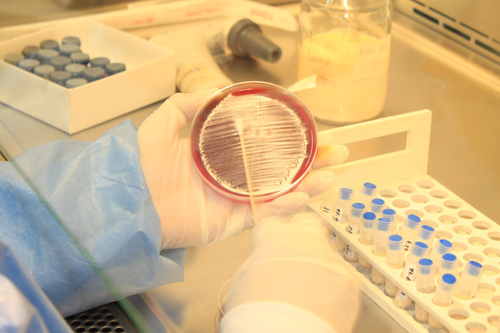 As WHO’s Contact Point for the International Health Regulations (IHR) in the Americas, PAHO contributed to the detection and management of over 100 events of potential international public health concern during mid-2012 to mid-2013. As part of the risk management process, event verification (when applicable) was obtained within the 48-hour window stipulated by IHR, and all events were jointly assessed with States Parties. Information and guidance related to these public health events was disseminated through 22 epidemiological alerts and 67 reports. In addition, PAHO provided support for outbreak response, including the deployment of international experts to the Bahamas, Barbados, Belize, and Peru for outbreaks of dengue, carbapenemase-producing Klebsiella pneumoniae, Acinetobacter baumanii and Enterobacter cloacae. PAHO also supported Chile in responding to an unusual increase in cases of meningococcal disease caused by N. meningitidis W 135.
As WHO’s Contact Point for the International Health Regulations (IHR) in the Americas, PAHO contributed to the detection and management of over 100 events of potential international public health concern during mid-2012 to mid-2013. As part of the risk management process, event verification (when applicable) was obtained within the 48-hour window stipulated by IHR, and all events were jointly assessed with States Parties. Information and guidance related to these public health events was disseminated through 22 epidemiological alerts and 67 reports. In addition, PAHO provided support for outbreak response, including the deployment of international experts to the Bahamas, Barbados, Belize, and Peru for outbreaks of dengue, carbapenemase-producing Klebsiella pneumoniae, Acinetobacter baumanii and Enterobacter cloacae. PAHO also supported Chile in responding to an unusual increase in cases of meningococcal disease caused by N. meningitidis W 135. Six of the 35 IHR States Parties in the Americas—Brazil, Canada, Chile, Colombia, Costa Rica, and the United States—determined that their core capacities for surveillance and response, including at designated points of entry, were in place by the established IHR deadline of June 2012. The remaining 29 States Parties obtained a two-year extension, until June 2014. PAHO provided support for these countries’ efforts to improve their core capacities through the implementation of National IHR Extension Action Plans 2012–2014.
IHR States Parties Annual Reports submitted to the 66th World Health Assembly showed considerable heterogeneity in the status of core capacities in countries of the Americas. Compared with the previous year, progress was noted in capacities related to designated points of entry, laboratories, management of events related to zoonotic and food safety hazards, and surveillance. The most critical weaknesses were related to capacities for managing events associated with chemical and radiation hazards. To accelerate capacity building, PAHO partnered with the IAEA to organize two workshops for Caribbean Community (CARICOM) countries in 2012 and a workshop for the countries of the Central American Integration System (SICA) in 2013.
Although the spread of cholera in Hispaniola has slowed compared with the epidemic’s early stages, Haiti and the Dominican Republic continued to battle the disease in 2012–2013. Between mid-2012 and mid-2013¹, Haiti reported 103,046 new cholera cases and 850 deaths, while the Dominican Republic reported 5,220 new cases and 52 deaths.
¹Epidemiological week 23 in 2012 to week 23 in 2013.
Regional Coalition to Eliminate Cholera in Hispaniola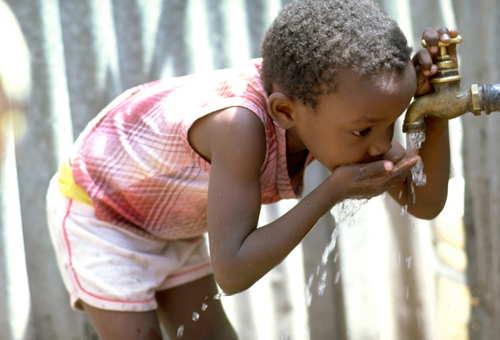
An important development was the creation in June 2012 of the Regional Coalition for Water and Sanitation to Eliminate Cholera in Hispaniola by PAHO in partnership with UNICEF, the U.S. Centers for Disease Control and Prevention (CDC), the Spanish Agency for International Development Cooperation (AECID), and the Inter-American Association of Sanitary Engineering (AIDIS). Launched at AIDIS’s 33rd congress in Salvador, Bahia, Brazil, the coalition was a response to a January 2012 “call to action” by the governments of Haiti and the Dominican Republic for the international community to mobilize resources to support major new investments in water and sanitation to make it possible to eliminate cholera. |
Influenza surveillance continued to improve in the countries of the Americas during 2012–2013. With the implementation of the Severe Acute Respiratory Illness (SARI) Surveillance System, 62 hospitals in 13 countries were reporting weekly data by June 2013 using internationally accepted indicators.
In addition, 27 national influenza centers throughout the Region were compiling, analyzing, and disseminating weekly virologic data to monitor seasonal influenza viruses and viruses with pandemic potential and to contribute to the selection of global vaccine strains. To integrate laboratory and epidemiologic data in the countries, PAHO developed an information system, PAHOFlu, which was installed in 14 hospitals and nine laboratories in Bolivia and Chile, with plans to expand the system to other countries of the region.
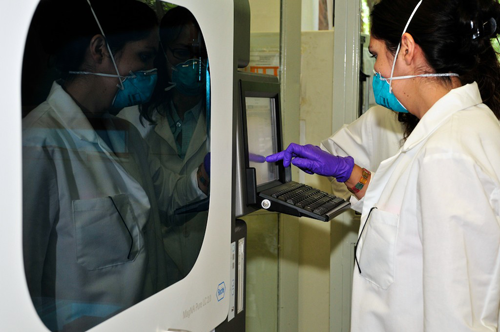 Twenty of the Region’s countries were by mid-2013 participating in a surveillance system for anti-microbial resistance based on routine data from microbiological laboratories. Five countries—Barbados, Ecuador, Guatemala, Panama, and Paraguay—strengthened their capacity to identify, investigate, and respond to outbreaks linked to health care.
Twenty of the Region’s countries were by mid-2013 participating in a surveillance system for anti-microbial resistance based on routine data from microbiological laboratories. Five countries—Barbados, Ecuador, Guatemala, Panama, and Paraguay—strengthened their capacity to identify, investigate, and respond to outbreaks linked to health care.
The dissemination of microbiology standards contributed to standardization and agreement on procedures for the regional Surveillance Network on Antimicrobial Resistance. Among new pathogens being monitored by national public health laboratories was Neisseria gonorrhoeae, which has developed resistance to third-generation cephalosporin antibiotics.
As part of its work to strengthen laboratory capacity, PAHO assisted 18 national information centers and laboratories in improving their ability to perform real-time PCR and immunofluorescence for influenza and other respiratory viruses and provided essential supplies for laboratory diagnosis of bacterial meningitis and pneumonia in 14 countries and at CAREC.
The Organization facilitated the inspection of laboratories in Brazil (National Institute of Quality Control in Health), Colombia (National Institute for Food and Drug Surveillance), and Mexico (Commission for Analytical Control and Expansion of Coverage). In September 2012, the 10th phase of PAHO’s External Quality Control Program for official laboratories responsible for the quality control of drugs was carried out in 23 countries, with a focus on pyrazinamide tablets for treatment of tuberculosis.
PAHO developed a guide based on the Stepwise Improvement Process for strengthening laboratory quality management systems for the Caribbean, in consultation with health experts from 22 countries and territories. Professionals from 31 countries were trained in bio-risk management and were certified in the safe transport of infectious samples.
Veterinary public health and food safety
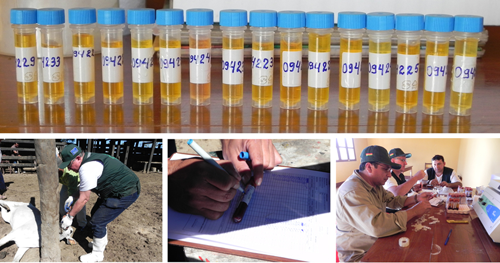 Through its Pan American Center on Foot-and-Mouth Disease (PANAFTOSA), PAHO provided technical cooperation on veterinary public health and food safety, focusing on the elimination of foot-and-mouth disease and human rabies while also working to strengthen national capacities to reduce the risks of zoonoses and food-borne illness.
Through its Pan American Center on Foot-and-Mouth Disease (PANAFTOSA), PAHO provided technical cooperation on veterinary public health and food safety, focusing on the elimination of foot-and-mouth disease and human rabies while also working to strengthen national capacities to reduce the risks of zoonoses and food-borne illness. During the reporting period, the Region of the Americas experienced no outbreaks of foot-and-mouth disease, complying with the commitments of the Hemispheric Program for the Eradication of Foot and Mouth Disease. At the country level, Peru was declared free of foot-and-mouth disease in May 2012, Ecuador remained free of outbreaks for its second consecutive year, and Bolivia expanded the area free of disease to 40% of its territory. Meanwhile, Paraguay was in the process of being certified as free of foot-and-mouth disease with vaccination.
Seven countries—Brazil, Chile, Colombia, the Dominican Republic, Ecuador, Haiti, and Peru—strengthened laboratories for diagnosing rabies through training and the establishment of a new Latin American and Caribbean Network of Rabies Diagnosis Laboratories. Haiti and the Dominican Republic updated their programs to control rabies transmitted by dogs.
A new regional Food Safety Strategy for 2013–2017 was endorsed by the Pan American Commission for Food Safety (COPAIA 6) and by 15 countries during the 2012 Inter-American Meeting at the Ministerial Level on Health and Agriculture (RIMSA 16). Five countries—Bolivia, Panama, Peru, Uruguay, and Venezuela—strengthened their laboratory capacity for analysis of food-borne pathogens. In addition, a South-South cooperation project between Brazil, Colombia, and Cape Verde and a North-South effort between Canada and Caribbean countries were expanded to include strengthening of food safety along with capacity building for evaluating microbiological and chemical risks.
Health information and analysis
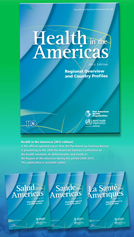 PAHO published the latest edition of its flagship publication, Health in the Americas, 2012 edition, during the reporting period. This comprehensive quinquennial report provides essential, accessible regional and country health data and analysis for health authorities, policymakers, academicians, students, other analysts, and the general public.
PAHO published the latest edition of its flagship publication, Health in the Americas, 2012 edition, during the reporting period. This comprehensive quinquennial report provides essential, accessible regional and country health data and analysis for health authorities, policymakers, academicians, students, other analysts, and the general public. At the country level during 2012–2013, Antigua and Barbuda, the Bahamas, Haiti, and Jamaica developed new policies and action plans for their health information systems to improve the quality of their surveillance data. The Dominican Republic, Ecuador, and El Salvador began using the web-based ViEpi epidemiological surveillance system, and Jamaica installed an integrated surveillance system for vaccine-preventable diseases. In addition, 13 countries strengthened their capacity to guide health sector priority setting and decision-making by developing national “Basic Indicators” brochures.
In 2012, 17 of 25 countries reached the agreed target on reporting national statistics on births. Additionally, 11 of 25 countries reached the target on reporting national statistics on deaths.²
²Targets for 2005 to 2013: countries with >90% coverage should at least maintain it; countries with 80-90% should reach at least 90%; countries with 61-79% should improve coverage by at least 10%; and countries with ≤60% should improve coverage by at least 20%. (Regional Plan of Action for Strengthening Vital and Health Statistics, CD48/9 [2008])
Twenty-five facilitators from Bolivia, Ecuador, Paraguay, and Peru and 100 coders from El Salvador, Guatemala, Honduras, and Nicaragua received training in the International Classification of Diseases, 10th Edition (ICD-10). Bolivia and Ecuador provided training on ICD-10 to some 200 health technicians through subnational courses. Eight countries—Argentina, Chile, Costa Rica, Ecuador, Guatemala, Paraguay, Uruguay, and Venezuela—began using an electronic system for coding mortality according to ICD-10, provided by Mexico.
Family, Gender, and Life Course
PAHO recognizes the central role of the family and community in promoting and protecting health as a social value and a human right and uses a life-course approach, addressing the specific needs of each population group. Technical cooperation in this area seeks to promote the health, nutrition, and comprehensive development of children from infancy through adolescence and protect achievements in immunization while expanding access to its benefits. A central priority of this work during the reporting period was to accelerate reductions in maternal and neonatal mortality.
Immunization
 The countries of the Americas continued to lead the way in the introduction of new vaccines where supported by the appropriate evidence. As of June 2013, 17 countries and territories had introduced rotavirus vaccine into their national immunization programs, protecting 86% of all children under age 1 in the Region. Twenty-one countries and five territories included pneumococcal vaccine in their routine schedules, covering 81% of children under 1. In addition, seven countries had introduced the human papillomavirus (HPV) vaccine, covering 51% of all girls aged 10-14 years in the Americas.
The countries of the Americas continued to lead the way in the introduction of new vaccines where supported by the appropriate evidence. As of June 2013, 17 countries and territories had introduced rotavirus vaccine into their national immunization programs, protecting 86% of all children under age 1 in the Region. Twenty-one countries and five territories included pneumococcal vaccine in their routine schedules, covering 81% of children under 1. In addition, seven countries had introduced the human papillomavirus (HPV) vaccine, covering 51% of all girls aged 10-14 years in the Americas.
Other new vaccine introductions during 2012–2013 included pentavalent vaccine in Haiti; pneumococcal conjugate vaccine in Argentina, Bahamas, Guatemala, Paraguay, and Trinidad and Tobago; inactive polio vaccine in Brazil, seasonal influenza vaccine in Dominica, and varicela and hepatitis A in Paraguay. A number of countries also made progress in expanding immunization coverage during 2012–2013.
PAHO’s technical cooperation in support of these achievements focused on capacity building for rapid monitoring of vaccine coverage and surveillance and analysis of data on vaccine-preventable diseases. In addition, PAHO’s ProVac initiative helped countries develop capacity for making evidence-based decisions on the introduction of new vaccines.
PAHO Revolving Fund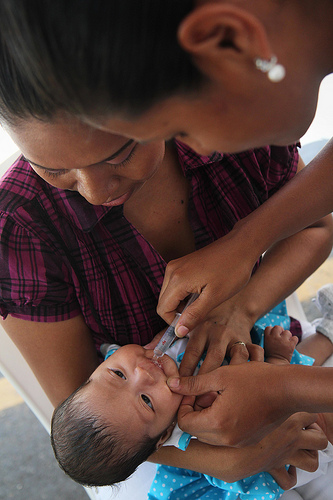
The PAHO Revolving Fund for Vaccine Procurement supported immunization achievements during the reporting period by providing credit lines and making bulk purchases on member countries’ behalf to ensure a continuous supply of high-quality vaccines and syringes for national immunization programs. By mid-2013, 39 countries and territories were participating in the Revolving Fund, which translates into more than $518 million dollars in vaccines acquired for the Region during 2012, 6.5 times the amount purchased in 2000. |
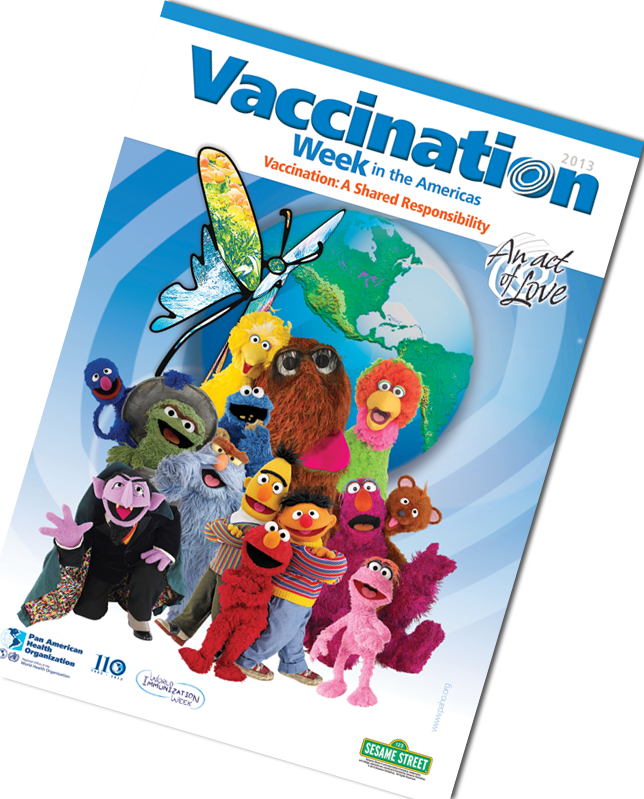 PAHO provided important support to help maintain the elimination of polio, measles, rubella and congenital rubella syndrome, including the development of a regional plan of action to strengthen rapid-response capacity in the countries. As part of these efforts, five countries—Argentina, Bolivia, Colombia, Ecuador and Haiti—received PAHO support for strengthening surveillance and outbreak response.
PAHO provided important support to help maintain the elimination of polio, measles, rubella and congenital rubella syndrome, including the development of a regional plan of action to strengthen rapid-response capacity in the countries. As part of these efforts, five countries—Argentina, Bolivia, Colombia, Ecuador and Haiti—received PAHO support for strengthening surveillance and outbreak response.
In April 2013, PAHO celebrated the 11th annual Vaccination Week in the Americas, the Americas’ largest regional health initiative. Forty-four countries and territories participated, reaching out to over 44 million people. All WHO regions also participated in the second World Immunization Week.
Maternal, child, and adolescent health
PAHO supported countries’ efforts throughout 2012–2013 to reduce maternal and child mortality through expanded coverage of antenatal care and childbirth with trained assistance, access to and use of contraceptives, and guidelines and training for improved obstetric and pediatric care. These and other interventions were in line with the 2011 regional Plan of Action to Accelerate the Reduction of Maternal Mortality and Severe Morbidity (CD51/12 [2011]) and the 2008 Regional Strategy and Plan of Action for Neonatal Health within the Continuum of Maternal, Newborn, and Child Care (CD48/7 [2008]), for which a mid-term evaluation was completed.
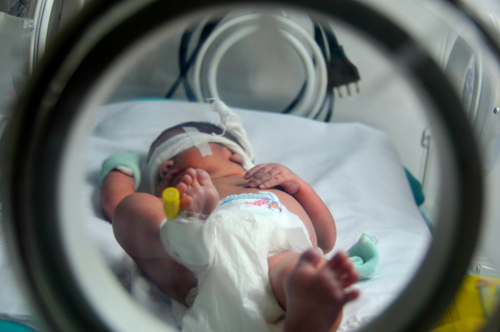 Countries including Argentina, Colombia, Dominica, the Dominican Republic, Haiti, and Paraguay developed or advanced the implementation of national programs to reduce neonatal mortality and improve maternal health, with PAHO support. Guyana implemented a neonatal care program at its main hospital that significantly lowered neonatal mortality in the facility. Guatemala adapted and implemented the Code Red strategy for managing obstetric hemorrhage, while Brazil launched the new Stork Network (Rede Cigonha), which makes use of expert committees and social mobilization to reduce maternal and neonatal mortality.
Countries including Argentina, Colombia, Dominica, the Dominican Republic, Haiti, and Paraguay developed or advanced the implementation of national programs to reduce neonatal mortality and improve maternal health, with PAHO support. Guyana implemented a neonatal care program at its main hospital that significantly lowered neonatal mortality in the facility. Guatemala adapted and implemented the Code Red strategy for managing obstetric hemorrhage, while Brazil launched the new Stork Network (Rede Cigonha), which makes use of expert committees and social mobilization to reduce maternal and neonatal mortality.
In a collaborative effort with Texas Children’s Hospital, a PAHO/WHO Collaborating Center, El Salvador’s San Juan de Dios Hospital in the department of San Miguel and Panama’s Children’s Hospital became centers of excellence for training in classification, evaluation, and treatment of pediatric emergencies.
During 2012–2013, CLAP’s Perinatal Information System (SIP) was being used as the national standard in nine countries and was being implemented as the national standard in six others: Bahamas, Belize, Colombia, Costa Rica, Guyana, and Mexico. In a technical cooperation between countries (TCC) project, El Salvador, Honduras, Nicaragua, and Panama strengthened their use of SIP to produce better and more complete information, particularly in the area of mother-to-child transmission of HIV and syphilis. Also, a methodology for validating the achievement of targets for eliminating mother-to-child transmission of HIV and congenital syphilis was developed and pilot tested in Chile and Saint Lucia.
With support from PAHO and the UN Development Group for Latin America and the Caribbean (UNDG-LAC), six countries—Bolivia, Brazil, Guatemala, Honduras, Mexico, and Peru—elaborated a roadmap for implementing the Information and Accountability on Women’s and Children’s Health framework for reporting, oversight, and accountability on women's and children's health. These roadmaps will be submitted to WHO for financing of priority implementation activities and are expected to help guide the allocation of future resources from other sources.
 PAHO supported member countries’ efforts to address multiple health challenges facing adolescents and youths in the Americas. These include high fertility rates, substance abuse, violence, and the rising trend in physical inactivity and overweight/obesity. Low-income, cross-border, and ethnic minority youths are disproportionately affected by many of these problems, and PAHO focused both research and intervention on these groups. The Organization also supported member countries in the areas of risk prevention and promotion of healthy behaviors at the individual, family, and community levels.
PAHO supported member countries’ efforts to address multiple health challenges facing adolescents and youths in the Americas. These include high fertility rates, substance abuse, violence, and the rising trend in physical inactivity and overweight/obesity. Low-income, cross-border, and ethnic minority youths are disproportionately affected by many of these problems, and PAHO focused both research and intervention on these groups. The Organization also supported member countries in the areas of risk prevention and promotion of healthy behaviors at the individual, family, and community levels.
By 2013, 28 countries had established national adolescent health programs and were moving forward with their implementation in regions and departments. PAHO’s support for these efforts emphasized a life course, gender, and human rights framework and a focus on vulnerable and at-risk populations. Key areas of work included prevention of gender-based violence, comprehensive sexual and reproductive health services, and prevention of adolescent pregnancy and HIV/AIDS.
PAHO collaborated in an initiative supported by the Government of Norway to improve adolescent health in countries including the Dominican Republic, El Salvador, Guatemala, Haiti, Honduras, Nicaragua, and Panama. Six of these developed strategies during 2012–2013 to adapt health policies to the health and development needs of adolescents, based on interventions and services recommended by the Integrated Management of Adolescent Needs (IMAN) Strategy. Bolivia, Colombia, Ecuador, and Peru implemented the Strengthening Families Program—supported by PAHO, the European Union, and PRADICAN (Program against Illicit Drugs in the Andean Community)—to reduce risky behaviors among adolescents and strengthen communication between parents and teens.
With technical and financial support from PAHO and the U.S. CDC, the Eastern Caribbean countries carried out the Caribbean Health Survey, the results of which showed illicit drug use, violence, teen pregnancy, and obesity/lack of physical activity as major health issues facing the subregion’s adolescents. Based on the survey’s findings, Barbados, St. Kitts and Nevis, and St. Vincent and the Grenadines developed adolescent health policies in line with the PAHO Regional Strategy for Improving Adolescent and Youth Health (CD48/8 [2008]).
Nutrition
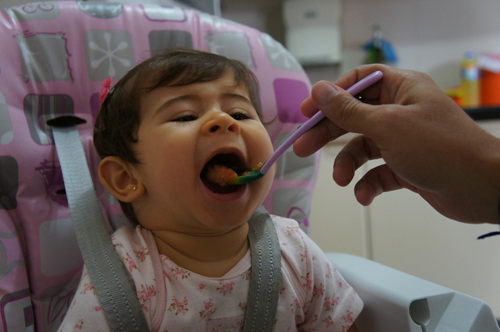 PAHO supported the development and implementation of national strategic nutrition plans in a number of the Region’s countries. In infant and young child nutrition, the Organization supported countries in implementing, regulating, and monitoring the Code of Marketing of Breast-milk Substitutes. This work contributed to legislation passed by El Salvador’s congress, a breastfeeding policy decreed by Mexico’s secretary of health, and a regulation to implement legislation on the breast-milk code signed by Panama’s president. PAHO supported sending teams from Chile and Mexico to Brazil to observe their successful breastfeeding program and human milk banking. A tool to promote programming in breastfeeding and complementary feeding, ProPAN (Process for the Promotion of Child Feeding), was finalized and widely distributed through face-to-face meetings and webinars.
PAHO supported the development and implementation of national strategic nutrition plans in a number of the Region’s countries. In infant and young child nutrition, the Organization supported countries in implementing, regulating, and monitoring the Code of Marketing of Breast-milk Substitutes. This work contributed to legislation passed by El Salvador’s congress, a breastfeeding policy decreed by Mexico’s secretary of health, and a regulation to implement legislation on the breast-milk code signed by Panama’s president. PAHO supported sending teams from Chile and Mexico to Brazil to observe their successful breastfeeding program and human milk banking. A tool to promote programming in breastfeeding and complementary feeding, ProPAN (Process for the Promotion of Child Feeding), was finalized and widely distributed through face-to-face meetings and webinars. In Central America, the Dominican Republic, and Paraguay, PAHO supported efforts to prevent chronic malnutrition and to develop norms and regulations for micronutrient supplementation and food fortification. The Organization also worked with countries to develop guidelines on the marketing of foods to children.
Oral health
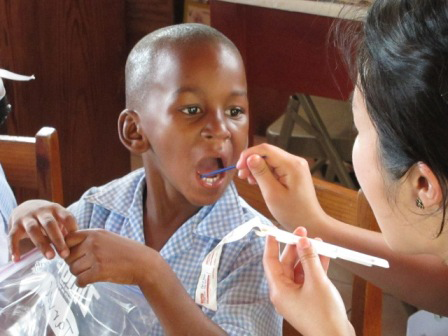 PAHO’s technical cooperation in oral health during the period included support for a study on the oral health status of school-age children in Barbados, using WHO’s 1987 protocol and the oral health component of Health Canada’s 2010 Canadian Health Measures Survey. The study found dental caries in 55% of Barbadian 6-year-olds, 43% of 12-year-olds, and 58% of 15-year-olds. The results compared unfavorably with figures from 2001, at 37%, 37%, and 45%, respectively.
PAHO’s technical cooperation in oral health during the period included support for a study on the oral health status of school-age children in Barbados, using WHO’s 1987 protocol and the oral health component of Health Canada’s 2010 Canadian Health Measures Survey. The study found dental caries in 55% of Barbadian 6-year-olds, 43% of 12-year-olds, and 58% of 15-year-olds. The results compared unfavorably with figures from 2001, at 37%, 37%, and 45%, respectively. PAHO also supported Haiti’s launch of a 2013–2022 strategic oral health plan, Paraguay’s systematic implementation of a national oral health policy, and Panama’s expansion of coverage with fluoridated water and implementation of the Caries-Free Communities strategy.
In 2013, PAHO and Colgate-Palmolive renewed a cooperation agreement that seeks to improve the oral health of children and adolescents living in remote communities in Colombia, Guatemala, Honduras, Mexico, and Peru. The collaboration will focus on training and raising awareness of the risk factors associated with oral diseases.
Aging
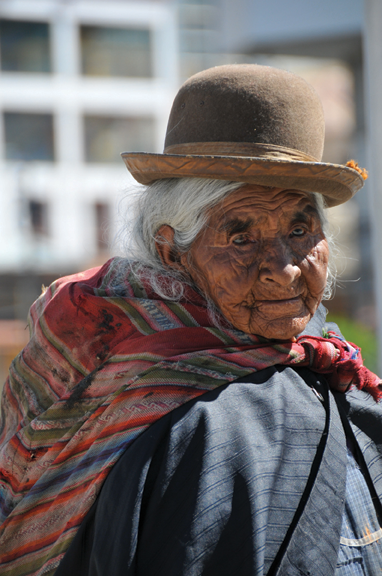 PAHO continued supporting member countries’ efforts to adapt their health policies and systems to address the changing needs of a rapidly aging population and to promote prevention to keep seniors healthy and active. As of 2013, 18 countries had developed policies, legal frameworks, and/or national plans on aging and health, and at least five others were in the process of developing them.
PAHO continued supporting member countries’ efforts to adapt their health policies and systems to address the changing needs of a rapidly aging population and to promote prevention to keep seniors healthy and active. As of 2013, 18 countries had developed policies, legal frameworks, and/or national plans on aging and health, and at least five others were in the process of developing them. More than 200 health managers from 18 Latin American and 11 Caribbean countries and territories were trained as part of a 10-month specialization program on public health and aging created by PAHO and partners to improve primary health care for older adults. In addition, PAHO brokered an agreement with the Inter-American Center for Social Security Studies and more than 15 Latin American and Caribbean universities to develop a Public Health and Aging Consortium that will advocate for healthy aging as a main public health priority. Argentina, Brazil, Chile, Colombia, Costa Rica, Cuba, Mexico, and the United States are currently represented in the consortium.
Noncommunicable Diseases and Mental Health
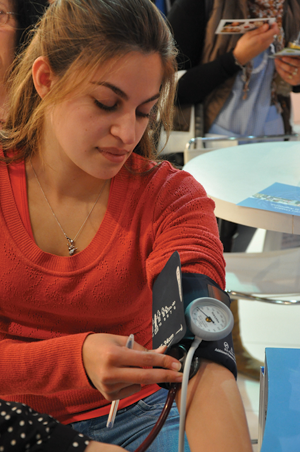 In September 2012, the 28th Pan American Sanitary Conference approved the Regional Strategy for Noncommunicable Diseases 2012–2025 (CSP28/9). The strategy is consistent with WHO’s global strategy and plan of action on NCDs and includes four main lines of action: policies and partnerships, risk and protective factors, a health system response, and surveillance and research. It emphasizes the four highest-burden NCDs in the Americas—cardiovascular disease, cancer, diabetes, and chronic respiratory diseases—and their four main risk factors—tobacco, unhealthy diet, physical inactivity, and harmful use of alcohol. The strategy seeks to raise the profile of NCDs on countries’ development and economic agendas and promotes an “all-of-society” approach involving governments, the private sector, academia, and civil society. In line with the new regional strategy, 10 countries—Antigua and Barbuda, Belize, Costa Rica, Dominica, Guyana, Nicaragua, Panama, Paraguay, Saint Kitts and Nevis, and Suriname—established or revised national multisectoral NCD policies, strategies, or plans during 2012–2013.
In September 2012, the 28th Pan American Sanitary Conference approved the Regional Strategy for Noncommunicable Diseases 2012–2025 (CSP28/9). The strategy is consistent with WHO’s global strategy and plan of action on NCDs and includes four main lines of action: policies and partnerships, risk and protective factors, a health system response, and surveillance and research. It emphasizes the four highest-burden NCDs in the Americas—cardiovascular disease, cancer, diabetes, and chronic respiratory diseases—and their four main risk factors—tobacco, unhealthy diet, physical inactivity, and harmful use of alcohol. The strategy seeks to raise the profile of NCDs on countries’ development and economic agendas and promotes an “all-of-society” approach involving governments, the private sector, academia, and civil society. In line with the new regional strategy, 10 countries—Antigua and Barbuda, Belize, Costa Rica, Dominica, Guyana, Nicaragua, Panama, Paraguay, Saint Kitts and Nevis, and Suriname—established or revised national multisectoral NCD policies, strategies, or plans during 2012–2013. At the regional level, PAHO convened the new SaltSmart consortium, which brought together health and nutrition experts from governments, civil society, and universities with representatives of industry. In 2013, the consortium endorsed a multi-year plan to cut dietary salt consumption in the Americas in half by the year 2020. The plan proposes a series of commitments and actions, including campaigns to raise public awareness about the importance of salt reduction and steps to reduce salt in industrially processed foods.
Women’s Cancer InitiativeIn February 2013, PAHO launched the new Women’s Cancer Initiative, an alliance of public and private organizations committed to reducing breast and cervical cancer, the leading cancers among Latin American and Caribbean women. The initiative will undertake joint efforts in areas including advocacy and communication; capacity building for detection, diagnosis, treatment and care; improved access to services and treatment; wider vaccination against human papillomavirus (HPV); and expanded research. Along with the SaltSmart consortium, the Women’s Cancer Initiative was launched within the framework of the Pan American Forum for Action on NCDs (PAFNCD). |
Several countries implemented new or enhanced programs for NCD care into their health services. Dominica, Saint Lucia, Saint Vincent and the Grenadines, and Suriname launched programs for integrated management of chronic diseases focused on primary care, while Colombia, Ecuador, Jamaica, Mexico, and Peru developed new programs specifically for prevention and control of cancer. To support these and similar programs, PAHO defined a set of essential and affordable medicines for treatment of NCDs that member countries could purchase through the PAHO Strategic Fund.
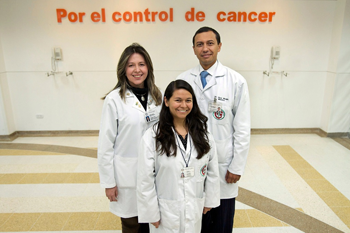
Argentina, Bolivia, El Salvador, Guatemala, Honduras, and Jamaica strengthened their national cervical cancer screening programs through training for health-care providers, improved quality of testing, increased screening coverage, and assured diagnosis and treatment for women with abnormal test results. At least a dozen other countries improved their cancer registration systems and procedures.
Sixteen countries implemented the Chronic Care Passport, a patient-held card developed through PAHO technical cooperation that fosters adherence to medication, encourages self-care and prevention, and facilitates NCD data collection. More than 1,500 health professionals and 500 patients from throughout the Region registered to take an online course on diabetes self-management offered through the Public Health Virtual Campus.
Legislation and regulation to address NCD risk factorsPAHO supported efforts in a number of countries to address NCDs and their risk factors through legislative and regulatory initiatives. Chile and Bolivia were among countries that enacted new laws complying with the Framework Convention on Tobacco Control (FCTC), while Bolivia set up an intersectoral commission for implementation of the FCTC. Antigua and Barbuda, Bolivia, Dominica, Grenada, Guyana, Peru, Saint Lucia, Saint Kitts and Nevis, and Saint Vincent and the Grenadines were by mid-2013 developing legislative proposals for FCTC implementation.
|
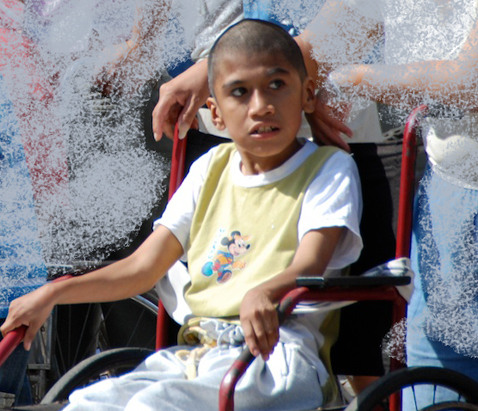 In the area of disabilities and rehabilitation, the Organization assisted Andean countries in developing a common policy on care for people with disabilities. Implementation began in Bolivia, Chile, Colombia, Ecuador, Peru, and Venezuela in the areas of development and strengthening of networks for comprehensive rehabilitation services; use of WHO’s International Classification of Functioning, Disability and Health (ICF); and interventions for social protection of people with disabilities.
In the area of disabilities and rehabilitation, the Organization assisted Andean countries in developing a common policy on care for people with disabilities. Implementation began in Bolivia, Chile, Colombia, Ecuador, Peru, and Venezuela in the areas of development and strengthening of networks for comprehensive rehabilitation services; use of WHO’s International Classification of Functioning, Disability and Health (ICF); and interventions for social protection of people with disabilities. Seven countries—Argentina, Bolivia, Chile, Colombia, Costa Rica, Paraguay, and Venezuela—began implementing the PAHO Community-based Rehabilitation strategy, and baseline information was updated on the situation of people with disabilities in nine countries: Argentina, Brazil, Chile, Ecuador, Mexico, Paraguay, Peru, Uruguay, and Venezuela.
Mental health
Countries throughout the Region advanced in the implementation of WHO’s Mental Health Gap Action Program (mhGAP). This Program promotes scaling up of services for mental, neurological, and substance use disorders. During the reporting period, 18 countries and territories in the Region were using mhGAP to integrate mental health into primary health services or to develop plans for this purpose.
 During 2012–2013, a number of countries and territories completed or advanced in developing mental health policies and legislation. Anguilla, Antigua and Barbuda, Barbados, the British Virgin Islands, Costa Rica, Panama, Suriname, and Venezuela developed new or updated existing national mental health policies and plans. Argentina promulgated regulations related to its Mental Health Law, which protects the rights of people suffering from mental disorders, while Jamaica and the British Virgin Islands carried out reviews of mental health legislation.
During 2012–2013, a number of countries and territories completed or advanced in developing mental health policies and legislation. Anguilla, Antigua and Barbuda, Barbados, the British Virgin Islands, Costa Rica, Panama, Suriname, and Venezuela developed new or updated existing national mental health policies and plans. Argentina promulgated regulations related to its Mental Health Law, which protects the rights of people suffering from mental disorders, while Jamaica and the British Virgin Islands carried out reviews of mental health legislation. Professionals from Anguilla, Antigua and Barbuda, and Jamaica received training on psychological first aid (PFA) in disasters and emergencies, and drafted mental health and psychosocial components for their national health disaster plans. The Bahamas, Suriname, and Trinidad and Tobago also provided training on mental health in disasters and PFA.
PAHO published the Regional Report on the Assessment of Mental Health Systems in Latin America and the Caribbean, which evaluates 34 countries and territories. The report provides a baseline for future evaluation of progress in mental health reform.
Harmful use of alcohol is a critical risk factor for mental health and other NCDs as well as for injuries and reproductive problems. To that end, PAHO supported a meeting of the Pan American Network on Alcohol and Public Health in 2012, in which representatives of 30 countries generated recommendations for implementing the 2011 Plan of Action to Reduce the Harmful Use of Alcohol. In 2013, PAHO launched several virtual courses in this area, including a course on alcohol screening and brief interventions for health workers and courses on public health and alcohol and drug policies for health policymakers. The Organization also worked throughout 2012–2013 to strengthen countries’ implementation of the 2011 Plan of Action on Psychoactive Substance Use and Public Health, providing technical cooperation to ministries of health in coordination with other sectors.
Sustainable Development and Environmental Health
 PAHO worked to strengthen member countries’ capacities to address environmental health issues and social determinants of health through intersectoral work and promotion of “health in all policies.” PAHO participated in the global and regional processes such as the UN Conference on Sustainable Development (Rio+20), the Congress of the Inter-American Association of Sanitary Engineering (AIDIS), and other consultations to address these issues.
PAHO worked to strengthen member countries’ capacities to address environmental health issues and social determinants of health through intersectoral work and promotion of “health in all policies.” PAHO participated in the global and regional processes such as the UN Conference on Sustainable Development (Rio+20), the Congress of the Inter-American Association of Sanitary Engineering (AIDIS), and other consultations to address these issues. With PAHO support, Latin American and Caribbean countries advocated successfully on health issues at the June 2012 Rio+20 Conference. PAHO’s “Rio+20” toolkit and an ongoing seminar series provided information and space for debate on these issues for stakeholders in the health sector. In February 2013, PAHO and AECID organized a consultation on health in the post-2015 development agenda in Antigua, Guatemala, with civil society representatives and mayors of vulnerable municipalities from 15 countries. In addition, PAHO supported Saint Lucia in preparing for a UNDP-sponsored national consultation on the post-2015 agenda, one of 50 such consultations held around the world. PAHO also facilitated preparations for the 8th Global Conference on Health Promotion in Helsinki in June 2013 through the development and dissemination of a toolkit on “Health in All Policies.”
To follow up on the recommendations from the Rio Declaration on Social Determinants of Health, Belize, the Dominican Republic, and Trinidad and Tobago established intersectoral committees during the reporting period. Argentina, Brazil, Canada, Chile, Costa Rica, Cuba, El Salvador, Mexico, and Peru strengthened their existing committees. With support from Canada and WHO, an analysis summarizing economic rationales for other sectors to address social determinants of health was conducted in Mexico, documented, and finalized. PAHO assisted Honduras and Peru in strengthening capacity to measure and monitor health disparities within the framework of social determinants of health.
PAHO worked with countries to build capacity to carry out intersectoral work and advocacy for “health in all policies” and to advance health equity. The Organization developed a tool to help countries document and systematize examples of intersectoral work at the national, subnational, and local levels that exemplifies the “health in all policies” approach. Sixteen countries used the tool to develop their own case studies. In addition, Brazil, Chile, El Salvador, and Mexico gathered evidence that a health-in-all-policies approach has important effects on health equity.
The Organization facilitated the presentation of several regional case studies at the 8th Global Conference on Health Promotion in Helsinki in June 2013. These included Brazil’s Bolsa Familia (“Family Allowance”) and Brazil sin Miseria (“Brazil without Poverty”) initiatives, Canada’s experience with “health equity in all policies,” Chile’s Choose Healthy Living initiative, Ecuador’s National “Good Living” Plan, El Salvador’s Intersectoral Health Commission (CISALUD), and Mexico’s National Accord for Nutritional Health - Strategy against Obesity.
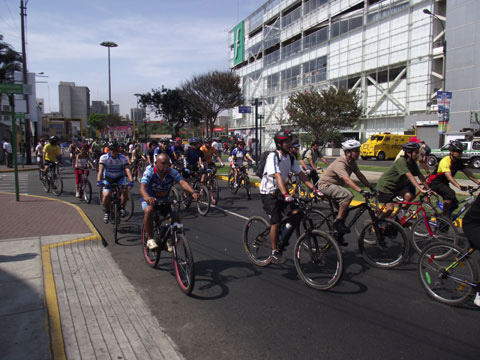
As part of its work promoting healthy settings, PAHO helped develop new digital platforms that integrate the websites and social media channels of the Healthy Schools Network, the International Ecoclubs Network, and the Ibero-American Network of Healthy Universities, with plans to develop similar platforms for the Healthy Municipalities and Communities Network. Ecuador became the first country to establish national norms for the accreditation of healthy markets, using concepts proposed by PAHO.
Also during the period, the Ciclovías (Open Streets) movement grew to include 354 participating towns, cities, and neighborhoods in the Americas. Some 240 of the newest programs are in Peru and are the result of new incentives for municipalities provided by the Ministry of Economy and Finance.
Violence and human security
In collaboration with the U.S. CDC, PAHO in 2012 published Violence against Women in Latin America and the Caribbean: A Comparative Analysis of Population-based Data from 12 Countries. This is the first comparative report with nationally representative data on violence against women in Latin America and the Caribbean. To facilitate future comparative analyses, PAHO supported an effort by the Andean Community of Nations to standardize indicators for gender-based violence.
In conjunction with PAHO/WHO Collaborating Centers, PAHO supported efforts to develop national plans for prevention of violence and injuries in Trinidad and Tobago and gender-based violence in Guyana, while helping to strengthen capacity for primary prevention of violence against women in Bolivia, Costa Rica, Ecuador, El Salvador, Guatemala, Paraguay, and Peru. In Guatemala, this work included the development of local plans for prevention of violence and crime, including gender-based violence, as part of the UN Joint Program on Conflict Prevention and Peacebuilding, sponsored by the MDG Achievement Fund.
 PAHO’s U.S.–Mexico border office helped implement a USAID-funded program in Ciudad Juárez, the Violence and Injury Prevention (VIP) Project, which has become a model for other cities and municipalities in Mexico. As part of this program, the Organization helped strengthen the Observatory for Safety and Peaceful Coexistence at the Autonomous University of Ciudad Juarez; build capacity among primary care and social service providers, first responders, and community organizations; and improve the knowledge management and communication skills of the media and the community.
PAHO’s U.S.–Mexico border office helped implement a USAID-funded program in Ciudad Juárez, the Violence and Injury Prevention (VIP) Project, which has become a model for other cities and municipalities in Mexico. As part of this program, the Organization helped strengthen the Observatory for Safety and Peaceful Coexistence at the Autonomous University of Ciudad Juarez; build capacity among primary care and social service providers, first responders, and community organizations; and improve the knowledge management and communication skills of the media and the community. PAHO provided training in information gathering and analysis on violence prevention, and by mid-2013 24 countries had appointed a focal point to provide data to WHO’s Global Status Report on Violence Prevention. With support from the U.S. CDC’s National Center for Injury Prevention and Control (NCIPC), a PAHO/WHO Collaborating Center, PAHO contributed to assessing and strengthening surveillance systems on violence and injuries in countries including Belize, Haiti, and Trinidad and Tobago.
PAHO supported the development and implementation of health components in projects to improve human security in Brazil, Colombia, and Guatemala, funded by the UN Trust Fund for Human Security. In 2012, the Organization launched a Technical Reference Document on Human Security Implications for Public Health, outlining a collaborative human security approach that brings together diverse organizations and policies to address the root causes of people’s vulnerabilities. During the reporting period, case studies of projects using such an approach were finalized in Brazil, Colombia, the Dominican Republic, Guatemala, Mexico, and Peru.
Chemical safety
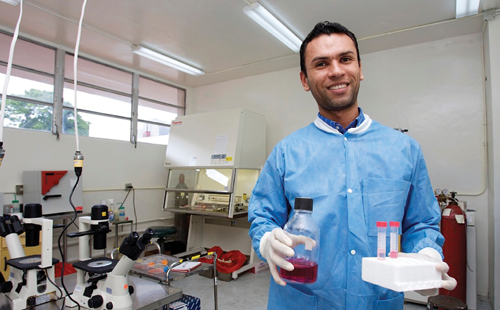 Fourteen countries of the Americas participated in the third session of the International Conference on Chemicals Management, held in Nairobi, Kenya, in September 2012. As a result of this participation, several countries submitted applications for resources from the Strategic Approach for International Chemical Management (SAICM), a policy framework for promoting chemical safety around the world.
Fourteen countries of the Americas participated in the third session of the International Conference on Chemicals Management, held in Nairobi, Kenya, in September 2012. As a result of this participation, several countries submitted applications for resources from the Strategic Approach for International Chemical Management (SAICM), a policy framework for promoting chemical safety around the world. Member States also took an active role in the intergovernmental negotiating committee drafting the Minamata Convention on Mercury, a legally binding global treaty to prevent chemical emissions and releases. As a result of the negotiations, an article on health was included in the final text of the treaty, which will be open for signature at a special meeting in Japan in October 2013. In related work, PAHO translated the WHO technical guidance document Replacement of mercury thermometers and sphygmomanometers in health care into Spanish and disseminated it in the Region of the Americas.
Workers’ and consumers’ health
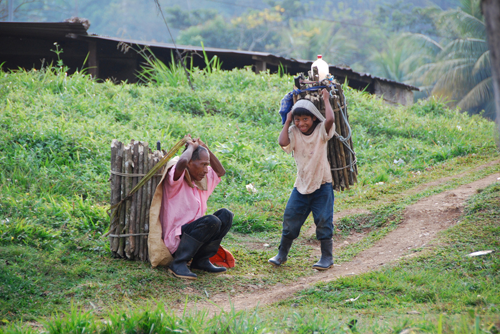 In December 2012, a “Call for Action on Workers’ Health and Safety in the Caribbean” was approved and endorsed by representatives of eight Caribbean countries and territories: Bahamas, Barbados, Belize, Grenada,. Jamaica, Saint Kitts and Nevis, Saint Lucia, and Turks and Caicos. The document calls for the creation of a Caribbean Plan of Action on Workers’ Health and Safety and urges an intersectoral approach. The effort was led by PAHO in collaboration with national labor and health authorities and St. George’s University in Grenada (a PAHO/WHO Collaborating Center), with support from Canada’s Department of Foreign Affairs, Trade, and Development (DFAIT), and the National Insurance Board (NIB) of the Bahamas, among others.
In December 2012, a “Call for Action on Workers’ Health and Safety in the Caribbean” was approved and endorsed by representatives of eight Caribbean countries and territories: Bahamas, Barbados, Belize, Grenada,. Jamaica, Saint Kitts and Nevis, Saint Lucia, and Turks and Caicos. The document calls for the creation of a Caribbean Plan of Action on Workers’ Health and Safety and urges an intersectoral approach. The effort was led by PAHO in collaboration with national labor and health authorities and St. George’s University in Grenada (a PAHO/WHO Collaborating Center), with support from Canada’s Department of Foreign Affairs, Trade, and Development (DFAIT), and the National Insurance Board (NIB) of the Bahamas, among others. In conjunction with CAREX Canada and PAHO/WHO Collaborating Centers, PAHO supported training on occupational cancer and estimating occupational exposure to carcinogens as part of efforts to build the regional CAREX, an information system with data on workers’ exposure to carcinogens. Five countries—Canada, Colombia, Costa Rica, Nicaragua, and Panama—participated in the construction of occupational exposure matrices that were used to raise awareness and empower 28 industrial hygienists in Latin America to use the methodology.
Experts on public health surveillance from 15 countries were mobilized during the reporting period to participate in the Consumer Safety and Health Network (RCSS), coordinated by PAHO and the Organization of American States (OAS). They received training in management of consumer product safety surveillance systems offered in conjunction with the Pompeu Fabra University of Barcelona.
Road Safety
 In the context of the UN Decade of Action for Road Safety (2011–2020), a number of countries in the Americas developed, approved, or implemented new plans and laws aimed at reducing traffic fatalities. These included Ecuador, which improved its legislation on traffic injury risk and protective factors (PAHO helped develop technical norms on the use of protective helmets by motorcyclists), as well as Dominica, Guyana, and Uruguay. El Salvador ratified a new Law for the National Fund for Victims of Traffic Accidents (FONAT), which prioritizes the problem of traffic accidents and deaths on the public agenda. In addition, Mexico progressed in its implementation of the Mexican Road Safety Initiative (IMESEVI) in all 31 states. In late 2012, Brazil incorporated all state capitals and the Federal District into its Vida no Trânsito (“Life in Traffic”) project, which focuses on speed management and reducing drunk driving.
In the context of the UN Decade of Action for Road Safety (2011–2020), a number of countries in the Americas developed, approved, or implemented new plans and laws aimed at reducing traffic fatalities. These included Ecuador, which improved its legislation on traffic injury risk and protective factors (PAHO helped develop technical norms on the use of protective helmets by motorcyclists), as well as Dominica, Guyana, and Uruguay. El Salvador ratified a new Law for the National Fund for Victims of Traffic Accidents (FONAT), which prioritizes the problem of traffic accidents and deaths on the public agenda. In addition, Mexico progressed in its implementation of the Mexican Road Safety Initiative (IMESEVI) in all 31 states. In late 2012, Brazil incorporated all state capitals and the Federal District into its Vida no Trânsito (“Life in Traffic”) project, which focuses on speed management and reducing drunk driving. The Mesoamerica Road Safety Plan, developed with assistance from PAHO and WHO, was unanimously approved by ministers of health, infrastructure, and transportation from 10 countries: Belize, Colombia, Costa Rica, the Dominican Republic, El Salvador, Guatemala, Honduras, Mexico, Nicaragua, and Panama. Based on a global model developed by the UN Road Safety Group, the plan provides a basis for action that can be contextualized in different cultures, and by different governments, businesses, and institutions.
Water and sanitation
PAHO worked with countries to develop and implement water and sanitation (WATSAN) strategies and plans. These included Ecuador, El Salvador, and Honduras as well as Nicaragua, which implemented a program focused on removing arsenic from water supplies in rural communities. Grenada developed a Water Safety Plan based on the methodology developed by WHO and the International Water Association, while Colombia, Costa Rica, and Paraguay implemented the methodology at the ministerial level and locally with local partners.
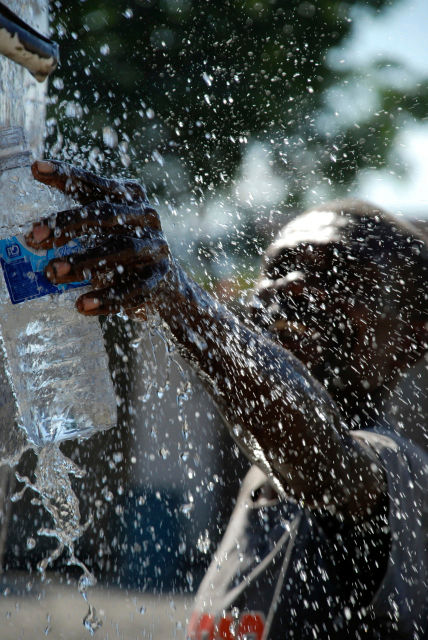 In addition, PAHO supported an assessment of water, sanitation, and hygiene in the Bahamas and supported the implementation of water quality monitoring parameters in Antigua and Barbuda. In collaboration with UNICEF, PAHO facilitated technology transfer from Haiti to the Dominican Republic and Colombia for surveillance and monitoring of water quality using short message service (SMS), or text messaging. The initiative will provide the basis for development of a regional guide on this subject.
In addition, PAHO supported an assessment of water, sanitation, and hygiene in the Bahamas and supported the implementation of water quality monitoring parameters in Antigua and Barbuda. In collaboration with UNICEF, PAHO facilitated technology transfer from Haiti to the Dominican Republic and Colombia for surveillance and monitoring of water quality using short message service (SMS), or text messaging. The initiative will provide the basis for development of a regional guide on this subject. In collaboration with the International Water Management Institute (IWMI) and the Swiss Tropical and Public Health Institute (TPH), PAHO assisted with the identification of five Resource Recovery and Reuse sites in Lima, Peru, for two pilot projects that will generate evidence on the application of Sanitation Safety Plans (SSPs) for WHO’s upcoming SSP manual.
PAHO developed new regional coordination tools for risk management in water, sanitation, and hygiene during emergencies. These include a “coordination checklist” and a “rapid guide” for establishing different responsibilities between the UN Cluster and a new Virtual Coordination Platform. Nine countries—Belize, Colombia, Costa Rica, Ecuador, El Salvador, Guatemala, Honduras, Nicaragua, Paraguay—incorporated these tools into their water and sanitation coordination mechanisms with PAHO support. A new PALTEX textbook, Water and Sanitation: New Paradigms, was launched in Belo Horizonte during the AIDIS meeting.
PAHO also promoted country involvement in and follow-up of the 2012 Global Analysis and Assessment of Sanitation and Drinking Water (GLAAS 2012), and Member States provided contributions and feedback on proposed goals for water and sanitation in the post-2015 development agenda.
Disaster Preparedness and Response
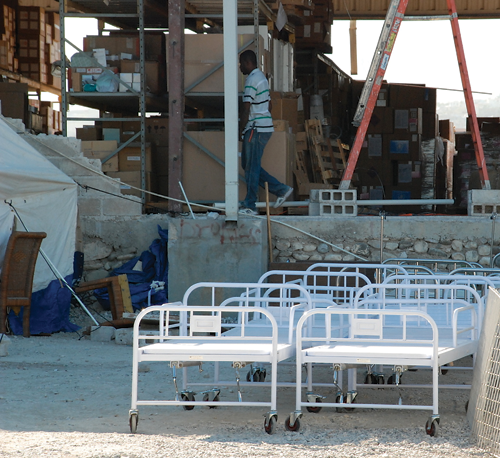 Following extensive consultations with countries and other stakeholders, PAHO’s Emergency Preparedness and Disaster Relief program in 2012–2013 revised its strategic approach to comprise three main lines of work: improving capacity of Member States to provide a timely and appropriate response to disasters, complex emergencies, and other crises; enhancing capacity of national health systems for emergency preparedness and disaster risk reduction; and increasing the effectiveness of PAHO and the UN Health Cluster in responding to disasters. Technical cooperation ranged from leadership and advocacy to training, technical guidance, and provision of software, manuals, tools, and equipment. In addition, PAHO coordinated the deployment of experts to assist countries’ health sector response during emergencies.
Following extensive consultations with countries and other stakeholders, PAHO’s Emergency Preparedness and Disaster Relief program in 2012–2013 revised its strategic approach to comprise three main lines of work: improving capacity of Member States to provide a timely and appropriate response to disasters, complex emergencies, and other crises; enhancing capacity of national health systems for emergency preparedness and disaster risk reduction; and increasing the effectiveness of PAHO and the UN Health Cluster in responding to disasters. Technical cooperation ranged from leadership and advocacy to training, technical guidance, and provision of software, manuals, tools, and equipment. In addition, PAHO coordinated the deployment of experts to assist countries’ health sector response during emergencies. During the reporting period, 21 new disaster risk reduction and response grants were mobilized, totaling some $10 million. The funds supported disaster response in nine countries: Colombia (internally displaced persons), Cuba and the Dominican Republic (for Hurricane Sandy), El Salvador (tropical depression 12), Guatemala (San Marcos earthquake), Haiti (for Hurricane Sandy and cholera), Panama (internally displaced persons) Paraguay (flooding), and Peru (dengue and flooding). The funds also supported disaster risk reduction and preparedness in the Dominican Republic, Grenada, Guyana, Haiti, Jamaica, Saint Lucia, Suriname, and Trinidad and Tobago and for the Region as a whole.
In June 2012, PAHO inaugurated its new Emergency Operations Center (EOC) in Washington, D.C., and adopted a new policy and procedures to improve its delivery of cooperation during emergency response operations. The EOC follows an Incident Management System model with three levels of activation: level 1, during events of lesser impact for which PAHO’s country office can provide the necessary support, and level 2 or 3 during higher-impact disasters that require mobilization of varying levels of international support.
PAHO also increased its surge capacity to respond to emergencies through training of existing as well as new members of the Regional Health Response Team. The team includes experts in epidemiological surveillance, alert and response, emergency logistics, water and sanitation, mental health, and risk communication, among other fields. Members are mobilized from among PAHO’s own staff and from partner organizations such as ministries of health and universities.
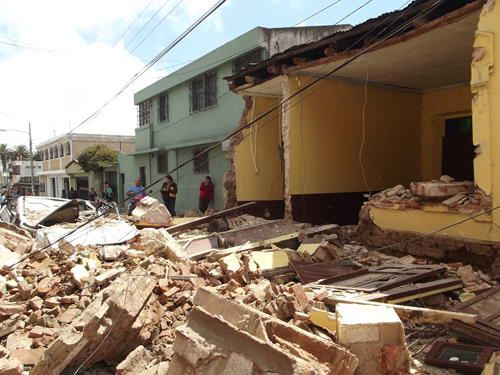 During the reporting period, members of the Regional Health Response Team were mobilized to support seven PAHO Member States during disasters: Haiti (Hurricane Isaac), Jamaica (Hurricane Sandy), Ecuador (floods in Costa and Sierra), Costa Rica (earthquake in Nicoya), Guatemala (San Marcos earthquake), Peru (dengue outbreak), and the Dominican Republic (cholera outbreak in Higuey Prison).
During the reporting period, members of the Regional Health Response Team were mobilized to support seven PAHO Member States during disasters: Haiti (Hurricane Isaac), Jamaica (Hurricane Sandy), Ecuador (floods in Costa and Sierra), Costa Rica (earthquake in Nicoya), Guatemala (San Marcos earthquake), Peru (dengue outbreak), and the Dominican Republic (cholera outbreak in Higuey Prison). At the country level, Argentina, Bolivia, Colombia, Chile, Ecuador, Paraguay, and Peru established national disaster response teams to coordinate disaster surge support in the health sector, with PAHO support. The teams may also be deployed to neighboring countries during emergencies, either as South-South cooperation or as part of the PAHO Regional Health Response Team.
A number of countries strengthened their health response capacity in emergencies. Seven countries— Anguilla, Chile, Dominica, Jamaica, Peru, Saint Vincent and the Grenadines, and Trinidad and Tobago—developed or updated their health disaster plans during the period. Dominica and Jamaica trained first responders in emergency care and treatment, while Anguilla, Antigua, the Bahamas, and Jamaica trained responders in mental health and psychosocial support. Haiti and the Dominican Republic expanded their early warning and rapid response systems for epidemics to encompass all hazards, including environmental risks for health. Grenada developed standard operating procedures for a new health Emergency Operations Center, identified a suitable location, and prepared a list of basic equipment needed for the EOC.
The Logistics Support/Supply Management System (LSS/SUMA), developed by PAHO to manage humanitarian health supplies during emergencies, was formally adopted by Ecuador and Peru, while the Dominican Republic adopted the system in one national and eight regional supply warehouses.
Safe hospitals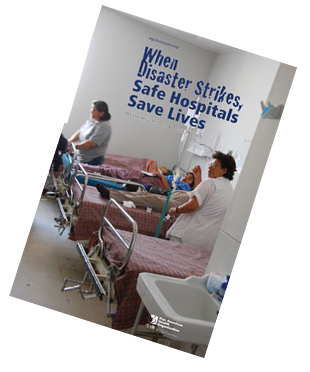 PAHO continued to promote risk reduction in the health sector through the Safe Hospitals Initiative and its Hospital Safety Index (HSI), a tool for assessing the probability that a health facility will remain functioning in emergency situations. By mid-2013, the HSI had been applied in more than 2,900 hospitals and other health facilities in 32 countries and territories of the Americas. During the reporting period, 20 countries used the HSI and implemented policies and strategies to improve the safety of existing hospitals. PAHO also updated the Hospital Safety Index for Small and Medium Hospitals and launched a new self-instruction course on how to use the HSI. At least 10 countries installed and used the online Safe Hospitals Database, developed by PAHO to monitor progress on the safe hospitals initiative and identify measures needed to protect the continued operation of health facilities during disasters. |
In partnership with the U.K. Department for International Development (UKAid), PAHO initiated the implementation of the Smart Hospitals initiative in the Caribbean, to reduce the carbon footprint of health facilities and improve disaster resiliency.
PAHO supported subregional efforts to improve disaster preparedness and response, including the new Andean Strategic Plan for Disaster Risk Management 2013–2017, approved by the ministers of health of the Andean region. The Ministers also named a Technical Commission for Emergencies and Disasters and appointed the directors of disasters offices in the ministries of health to implement the strategic plan. PAHO also helped update a guide for cooperation between Andean countries, which was approved by CAPRADE and served as a technical reference for the preparation of a similar guide for the MERCOSUR countries.
In partnership with the U.S. CDC, PAHO supported the creation of the Technical Commission for Risk Management in Central America and the Dominican Republic (CTGERS), an advisory body to COMISCA that will monitor disaster preparedness, response, and cooperation. A Central American Plan for Comprehensive Risk Management of Public Health Disasters and Emergencies 2013–2018 was developed with PAHO support and approved by COMISCA. It will guide work in the area of disasters and health and allow Member States of the Central American Integration System (SICA) to integrate cooperation mechanisms and strengthen health disaster units.
Knowledge Management and Communications
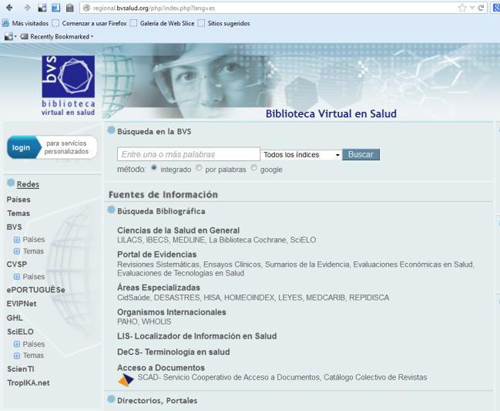 In 2012, the 28th Pan American Sanitary Conference approved the first regional strategy and plan of action on knowledge management and communications. It seeks to promote the development and dissemination of health information and knowledge based on scientific data; facilitate horizontal collaboration through partnerships and networks; and promote strategies for using knowledge to advance individual, social, and policy changes to improve and protect health.
In 2012, the 28th Pan American Sanitary Conference approved the first regional strategy and plan of action on knowledge management and communications. It seeks to promote the development and dissemination of health information and knowledge based on scientific data; facilitate horizontal collaboration through partnerships and networks; and promote strategies for using knowledge to advance individual, social, and policy changes to improve and protect health.
During 2012–2013, Bolivia, the Dominican Republic, El Salvador, Honduras, Panama, and Venezuela were among countries that established or expanded virtual health libraries (VHLs) with support from PAHO’s Latin American and Caribbean Center on Health Information Sciences (BIREME), in São Paulo, Brazil. Nine new institutions in Mexico’s Sonora state, along with Arizona State University, were incorporated into the Border Virtual Health Library (BVHL), for which PAHO’s U.S.-Mexico Border Office serves as secretariat. Mexico implemented a new Network of PAHO/WHO Collaborating Centers to facilitate the exchange of knowledge, experiences, and best practices among different centers.
PAHO/WHO Collaborating CentersNine new PAHO/WHO Collaborating Centers were designated in the Americas between mid-2012 and mid-2013, bringing the total number of active Collaborating Centers in the Region to 185—out of more than 800 centers globally. Collaborating Centers include research institutes, university departments and research centers, and other organizations that carry out activities in support of PAHO/WHO’s programs in a broad range of areas, from human resources for health to communicable and noncommunicable diseases, nutrition, mental health, health technologies, and many others. |
Six countries—Aruba, Brazil, Chile, Costa Rica, Guatemala, and Peru—received PAHO support to develop or implement new plans and strategies for promoting eHealth, which uses new information and communication technologies to improve health care. The future of eHealth initiatives was also a major focus of the 9th Regional Congress on Health Sciences Information (CRICS9), held at PAHO headquarters in October 2012, which drew more than 400 participants from 30 countries.
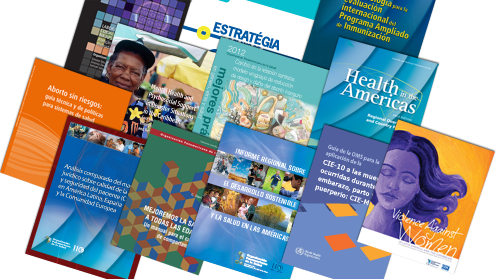 Between June 2012 and June 2013, PAHO published more than 250 scientific and technical publications. The Pan American Journal of Public Health, PAHO’s peer-reviewed scientific journal, published 13 issues during the period, including special issues on cardiovascular disease prevention and dietary salt reduction (October 2012) and equity in health systems (February 2013).
Between June 2012 and June 2013, PAHO published more than 250 scientific and technical publications. The Pan American Journal of Public Health, PAHO’s peer-reviewed scientific journal, published 13 issues during the period, including special issues on cardiovascular disease prevention and dietary salt reduction (October 2012) and equity in health systems (February 2013). Argentina, Cuba, Honduras, and Mexico participated in the PAHO Blue Trunk Library initiative, an effort to democratize access to health information by sending collections of up-to-date medical publications to remote communities using blue metal trunks. Brazil also participated through a South-South cooperation effort that provided publications to Portuguese-speaking countries.
During the reporting period, 20 countries gained access to the WHO HINARI platform, which provides free or very low cost online access to the major journals in biomedical and related social sciences to health institutions in more than 100 countries. Virtual learning platforms helped the Organization deliver new tools, concepts, and knowledge to more than 3,000 professionals in the Region.
Management and Governance
PAHO continued to pursue policies and practices aimed at enhancing management and efficiency, transparency, accountability, and ethics and fair treatment in the workplace. These efforts were initiated by the outgoing administration and received added impetus with the election of PASB’s new Director.
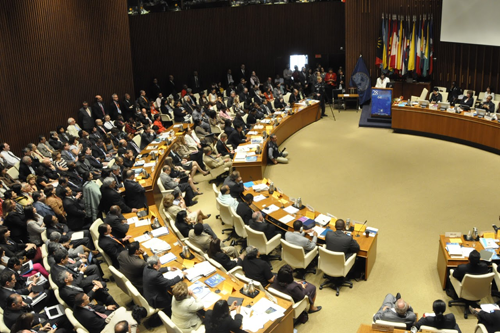 The Organization continued to implement a results-based management (RBM) framework during the reporting period, with important advancements made in conjunction with the development of the 2014–2019 Strategic Plan. These included a refined results chain to better reflect achievements and joint accountability of PASB and ministries of health, and improved results statements and indicators for outputs, outcomes, and impact. The new indicators will be incorporated into the Performance Monitoring and Assessment (PMA) process during the implementation of the new Strategic Plan. In addition, the PMA exercise—a key component of a results-based approach—enhances the management function in monitoring the progress of reporting departments and country offices, with a view to improving managerial accountability.
The Organization continued to implement a results-based management (RBM) framework during the reporting period, with important advancements made in conjunction with the development of the 2014–2019 Strategic Plan. These included a refined results chain to better reflect achievements and joint accountability of PASB and ministries of health, and improved results statements and indicators for outputs, outcomes, and impact. The new indicators will be incorporated into the Performance Monitoring and Assessment (PMA) process during the implementation of the new Strategic Plan. In addition, the PMA exercise—a key component of a results-based approach—enhances the management function in monitoring the progress of reporting departments and country offices, with a view to improving managerial accountability. In 2012, the 28th Pan American Sanitary Conference approved a new PAHO Budget Policy to guide resource allocation for operations at the regional, subregional, and country levels. It incorporates recommendations made by the office of Internal Oversight and Evaluation Services (IES) based on its evaluation of the previous budget policy, as well as adjustments in response to the Organization’s own lessons learned. Changes include new standards for country presence to ensure the availability of sufficient funds to maintain robust engagement with Member States, the incorporation of income inequality (the Gini coefficient) into an expanded needs-based assessment of countries, a results-based component designed to accelerate the achievement of programmatic targets in countries, and improved modeling and statistical techniques to provide more realistic and workable resource distribution results.
As part of the mid-term evaluation of the Health Agenda for the Americas 2008–2017 (SPBA7/4 [2013]), IES examined PASB’s implementation of the agenda. The evaluation confirmed that PAHO’s Strategic Plan 2008–2013 had been closely aligned with the Health Agenda for the Americas and that its strategic objectives had served to harmonize the agenda with WHO’s strategic objectives and with the work of other international organizations in the Region.
During 2012–2013, IES conducted audits in several country offices, assessing their adherence to results-based management, among other issues. However, IES also began an effort to collect and organize the vast amount of information available from previous evaluations. This process produced the Organization’s first list of all evaluations performed both internally and by external stakeholders, a critical first step in determining and understanding the lessons learned from these activities.
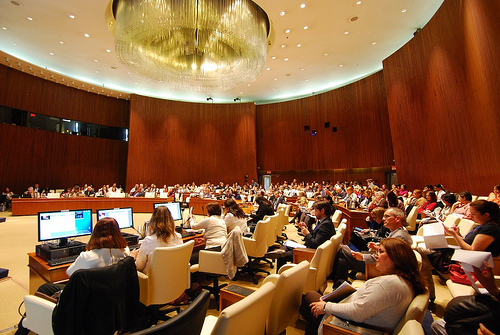 Several new initiatives, tools, and policies designed to streamline and enhance the Organization’s technical cooperation operations were rolled out during the reporting period. In August 2012, PASB approved a new information technology (IT) strategy and introduced a new IT governance process to coordinate the development of all expenditures on technology projects at PAHO headquarters, in country offices, and in collaborating centers. In addition, the internet domains of PAHO country offices and centers were merged into a single PAHO domain and computer software was standardized, to reduce complexity, increase security, simplify support, and facilitate the implementation of future information technology and knowledge management initiatives. The initial phases of a new “PAHO in the Cloud” initiative also were implemented, allowing Headquarters staff to access their desktop environments from anywhere and on any device and to remotely access PAHO tools, services, and shared repositories.
Several new initiatives, tools, and policies designed to streamline and enhance the Organization’s technical cooperation operations were rolled out during the reporting period. In August 2012, PASB approved a new information technology (IT) strategy and introduced a new IT governance process to coordinate the development of all expenditures on technology projects at PAHO headquarters, in country offices, and in collaborating centers. In addition, the internet domains of PAHO country offices and centers were merged into a single PAHO domain and computer software was standardized, to reduce complexity, increase security, simplify support, and facilitate the implementation of future information technology and knowledge management initiatives. The initial phases of a new “PAHO in the Cloud” initiative also were implemented, allowing Headquarters staff to access their desktop environments from anywhere and on any device and to remotely access PAHO tools, services, and shared repositories. PAHO continued to implement its enterprise risk management (ERM) program for identifying, monitoring, evaluating, and managing ongoing risks inherent in PAHO’s business operations and technical cooperation activities. During 2012–2013, a new PAHO Enterprise Risk Management Policy was approved and published in the PAHO/WHO E-Manual, and a new Enterprise Risk Management Handbook was published (linked to the country office Operations Manual). Risk assessments were performed for the PAHO Revolving Fund; for all the Organization’s administrative offices; for BIREME and the country offices in Chile and Mexico; and for nine country offices participating in a CIDA-funded project on women, children and excluded populations. In addition, 49 risk management focal points were trained in risk assessment at PAHO Headquarters and in Barbados, Brazil, and Panama.
In late 2012, the Organization developed a “business case” for using an enterprise planning system for PASB’s Management Information System (PMIS). Finalized in January 2013, the business case included a cost-benefit analysis of the project and recommendations on the selection of the appropriate software. Following a formal request-for-proposals process that concluded in mid-2013, the Organization identified the specific software to be used and the system-integrator company that will implement it.
Improvements to the Organization’s purchase of goods and services included staff training conducted at headquarters and in the country offices, the launch of a pilot project to implement an electronic tendering system in the Guatemala country office, and electronic tools that allow technical programs to track, monitor, and review their purchases of goods and services and track their delegation of authority in procurement matters. Procurement efforts on behalf of Member States included long-term agreements for the purchase of vaccines and syringes for countries’ national routine vaccination programs as well as antiretrovirals. PAHO also negotiated the procurement of new and strategic vaccines including yellow fever and HPV, while 16 new items were included in the Strategic Fund’s list of commodities.
Caribbean Public Health Agency, CARPHA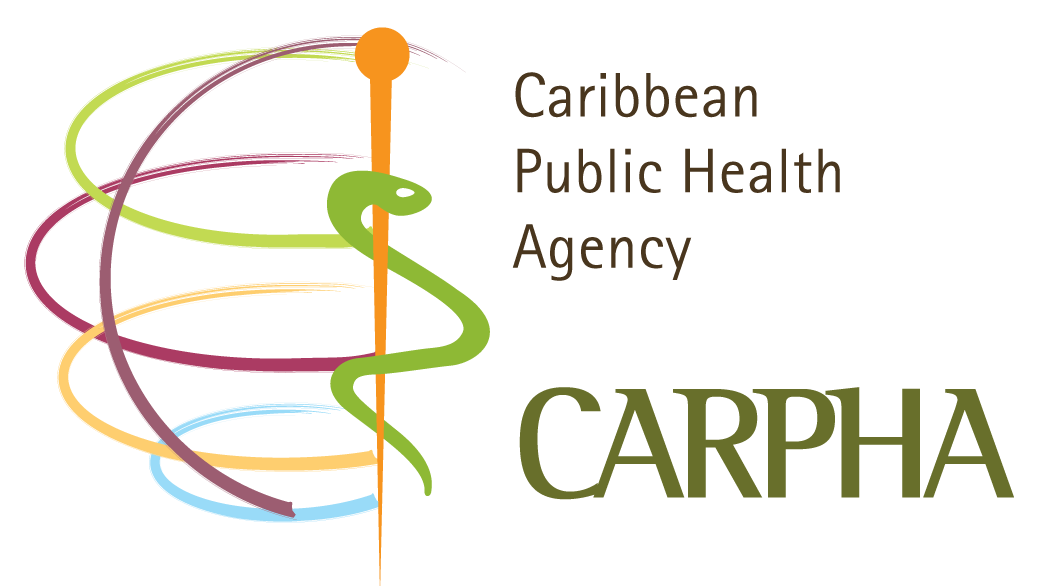
After more than 30 years of being administered by PAHO, the Caribbean Epidemiology Center (CAREC) and the Caribbean Food and Nutrition Institute (CFNI) were transferred during 2012-2013 to the Caribbean Public Health Agency (CARPHA), which became fully operational in January 2013. In addition to supporting the new agency’s development, PAHO provided extensive human resources support for the incorporation of CAREC and CFNI. Based in Trinidad and Tobago, CARPHA will provide a collective response to public health challenges for residents and visitors in the Caribbean. |
PAHO continued to offer extensive opportunities for its staff to develop new skills and knowledge during the reporting period. Initiatives included a new Learning Portal and individual learning plans for different units and departments. A new online Career Development Portal, launched in late 2012, provides tools for staff to enhance their professional growth, including a roadmap for career development, tools for career assessments and self-discovery, eLearning courses, and other information about career options, opportunities, and resources.
In addition to IES, several special offices and entities led the Organization’s efforts to promote transparency, ethics, and workplace fairness. They include the Ethics Office and the Ombudsperson, which together with IES, LEG, HRM, the Board of Appeal, and the Information Security Office (ISO), are part of PAHO’s Integrity and Conflict Management System. In addition, the PAHO Staff Association continued its active engagement with staff and the new administration to ensure fairness and equity.
During 2012, the PAHO Ethics Office addressed 84 consultations from staff and reviewed 43 reports of possible ethical breach, 32 of which came via the toll-free, confidential Ethics Help Line and 29 of which were submitted anonymously. The Ethics Office also provided training on PAHO’s Code of Ethical Principles and Conduct, published a brochure on “Zero Tolerance for Fraud and Corruption,” and issued specific guidelines for staff on how to remain neutral and objective during the process to elect PASB’s new Director.
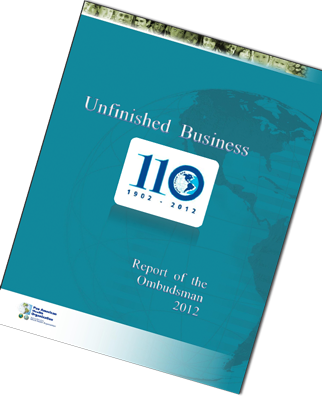 As coordinator of PAHO’s Integrity and Conflict Management System, the Ethics Office spearheaded a revision of the Organization’s policy on preventing and resolving workplace harassment. The new policy, issued in September 2012, broadened the scope of behaviors that constitute harassment and developed a special new form to facilitate reporting of formal allegations.
As coordinator of PAHO’s Integrity and Conflict Management System, the Ethics Office spearheaded a revision of the Organization’s policy on preventing and resolving workplace harassment. The new policy, issued in September 2012, broadened the scope of behaviors that constitute harassment and developed a special new form to facilitate reporting of formal allegations. The office of the PAHO Ombudsperson received 104 visitors from the Organization’s headquarters, country offices, and centers in 2012, expressing workplace concerns, frustrations, or problems. Top issues included supervisory effectiveness, department climate, respect and treatment, career progression and development, work-related stress and work-life balance, and administrative decisions and application of rules. The Office of the Ombudsman made a number of recommendations in its 2012 annual report, including the re-establishment of an “in-person” new employee orientation program, review of contract provisions regarding national and international PAHO consultants with a view to strengthening compliance with both their letter and spirit, and greater fairness and equity for PAHO workers contracted through employment agencies.
Back to top




